
september 2015 God Save The Queen! As Victoria’s record is surpassed, we compare the two reigns PAGE 58 “I Remember”: Midge Ure PAGE 30 Best of British: Subterranean PAGE 66 Celebrating 100 Years of the Women’s Institute PAGE 78 “They Were Vile Criminals” Actor Christopher Eccleston gets to grips with the Krays PAGE 20 Laugh .................................................140 Books that Changed my Life .............. 129 If I Ruled the World .............................86 Word Power ........................................133 Photo Competition Results .................74 september 2015 £3.79 readersdigest.co.uk




Eye catching.









NEW FORD ECOSPORT ZETEC with rear parking sensors and metallic paint from
Advance Payment . To find out more, visit ford.co.uk/Motability, or call 0345 60 40 019.
O cial fuel consumption figures in mpg (l/100km) for the Ford EcoSport range: urban 34.9-57.7 (8.1-4.9), extra urban 53.3-64.2 (5.3-4.4), combined 44.8-61.4 (6.3-4.6).
O cial CO2 emissions 149120g/km.
The mpg figures quoted are sourced from o cial EU-regulated test results (EU Directive and Regulation 692/2008), are provided for comparability purposes and may not reflect your actual driving experience.
*£Nil Advance Payment available only on Ford EcoSport Zetec 1.5 112 PS manual and 1.5 TDCi 90 PS. This programme is subject to the standard conditions of the Motability 3-year Contract Hire Scheme. Full written details and quotations available on request from a Ford Authorised participating Dealer of Motability Operations Limited. Under the Scheme the vehicles are leased from Motability Operations Limited (Registered Company No. 1373876), City Gate House, 22 Southwark Bridge Road, London SE1 9HB. Applications must be received and accepted by Motability Operations Limited between 1st July and 30th September 2015
£Nil*
features
12 Reasons to be chee R ful
James Brown discovers a shared interest with his son
e ntertainment
20 the man who nicked the k R ays
Actor Christopher Eccleston talks about his new film
Legend and why gangsters are still romanticised
30 “i Remembe R”: mid G e u R e
The musician on defying his parents, overcoming addiction and embracing charity Health
38 su P e R bu G s V s us
Why a number of viruses and bacteria are keeping the world’s top microbiologists busy
Inspire
58 a tale of two Q ueens
As Queen Elizabeth II surpasses
Victoria’s record to become our longest-serving monarch, we compare the two reigns

66 best of bR itish: s ubte RR anean
att R actions
There’s plenty to see if you delve beneath the surface
74 family h oliday P hoto com P etition
Get your entries in—it’s your last chance to win £400 or a fantastic trip to Turkey
78 “i’ Ve neVeR made jam!”
Celebrating the 100th birthday of the Women’s Institute—and overturning a few myths
travel & a dventure
90 alonG the wine Route
Want food and drink to die for?
Portugal is the place to explore
Cover Illustrat I on: © Ben t allon / © W enn l td/ a lamy 09•2015 | 1
Contents SEPTEMBER 2015
p20
e DI tor’s letter

this month sees a momentous day in British history.
Queen Elizabeth II will mark 63 years and 217 days on the throne on September 10, beating Queen Victoria’s record set on January 22, 1901. It’s a fantastic achievement, and we explore the legacies of both Elizabeth and Victoria—including events that helped to shape modern Britain—on p58.
Another great national treasure, the Women’s Institute, is also marking a significant milestone—its 100th birthday. The force behind numerous campaigns, the WI’s achievements go way beyond its jammy reputation, as revealed on p78. And moving from the sublime to the sleezy, we catch up with the great Christopher Eccleston on p20, who talks about his role in Legend, the new film about gangsters Ronnie and Reggie Kray.
Finally, time is fast running out to enter our photo competition. There’s £400 or a Turkish holiday up for grabs, so turn to p74 and get submitting!
 tom Browne
tom Browne
theeditor@readersdigest.co.uk
facebook.com/readersdigestuk
twitter.com/readersdigestuk
pinterest.com/rdigestuk
google.com/+readersdigestuK1
| 09•2015 2 IN e V er Y I ssue 6 over to you 8 s ee the World d ifferently e ntertainment 17 s eptember’s cultural highlights Health 48 advice: s usannah Hickling 54 Column: d r m ax Pemberton Inspire 86 If I ruled the World: daphne s elfe travel & a dventure 100 Column: Catherine Cole Money 106 Column: n ick Hill food & Drink 112 tasty recipes and ideas from rachel Walker Home & Garden 116 Column: lynda Clark technology 118 o lly m ann’s gadgets f ashion & Beauty 120 Georgina yates on how to look your best Books 124 september Fiction: James Walton’s recommended reads 129 Books that Changed my life: John Banville f un & Games 130 you Couldn’t m ake It u p 133 Word Power 136 Brain teasers 140 l augh! 143 Beat the Cartoonist 144 60-s econd stand- u p: m ark thomas
Reader’s Digest is published in 29 editions in 17 languages




































Editor-in-ChiEf Tom Browne
assistant Editor Fiona Hicks
digital Editor Mandi Goodier
art dirECtor Yvey Bailey
graphiC dEsignEr Katie Johnson
advErtising dirECtor Simon Fulton simon.fulton@readersdigest.co.uk 0203 701 5936
advErtising aCCount dirECtor Mike Allen mike.allen@readersdigest.co.uk 0203 701 5935
CEo Gary Hopkins
ChiEf opErating offiCEr Julie Leach
digital MarkEting and CaMpaigns
ManagEr Maggie Champion
digital ContEnt ExECutivE Kylie Petitt
thE rEadEr’s digEst assoCiation inC (usa) president and Chief Executive officer
Bonnie Kintzer
vice president, Chief operating officer, international Brian Kennedy
Editor-in-Chief, international Magazines
For all subscriber enquiries, please use the customer services number below
Raimo Moysa Write
W E pay...
£50 for the star letter and £30 for regular letters.
Email readersletters@readers digest.co.uk or go to readers digest.co.uk/contact-us
W E also pay...
£50 for the true stories, anecdotes, jokes in laugh! and you Couldn’t Make it up…, and contributions to end-ofarticle fillers and My great Escape
Email excerpts@readersdigest.co.uk or go to readersdigest.co.uk/contact-us
s orry!
We cannot acknowledge or return unpublished items or unsolicited article-length manuscripts. Do not send SAEs. Article-length stories, poetry and cartoons are not requested.
Custo ME r sE rvi CE s
Contact Customer services for renewals, gifts, address changes, payments, account information and all other enquiries. Call 0330 333 2220* or email customer_service@readersdigest.co.uk
talking M aga Z in Es
Reader’s Digest is available in a talking edition for blind and partially sighted people for £16. For details, call 01435 866 102, email info@tnauk.org.uk or visit tnauk.org.uk
su B s C ription s
Visit readersdigest.co.uk or write to: Reader’s Digest, PO Box 7853, Ringwood BH24 9FH. uk: £45.48 a year. republic of ireland: €61.20 a year. Prices include delivery. For gift subscriptions, contact Customer Services.
| 09•2015 4 *Calls to 03 numbers cost no more than a national rate call to an 01 or 02 number and will be free if you have inclusive minutes from any type of line including mobile, BT or other fixed line
to us! send us your stories, jokes and letters or Visit o ur Website small Print: Ensure submissions are not previously published. Include your name, email, address and daytime phone number with all correspondence. We may edit letters and use them in all print and electronic media. Contributions used become world copyright of Vivat Direct Ltd (t/a Reader’s Digest).
paper from sustainable forests. please recycle © 2015 Vivat Direct ltd (t/a reader’s Digest). british reader’s Digest is published by Vivat Direct ltd, 57 margaret street, london W1W 8sJ. all rights reserved throughout the world. reproduction in any manner, in whole or part, in english or other languages, is prohibited. reader’s Digest is a trademark owned and under license from the reader’s Digest association, inc, and is registered with the united states patent and trademark office. all rights reserved. classified advertising by madison bell. printed by polestar chantry, polestar uK print ltd. newstrade distribution by seymour Distribution limited.

Commiserations to Queen Victoria
To mark Elizabeth II becoming our longest reigning British monarch, the Reader’s Digest website is taking a step back in time. We’ll be looking at some of the UK’s proudest moments under her reign, as well as peering into our archives and featuring some historic royal articles.



Health writer Dr Helen Cowan gives us insight into our anatomy. Find out why:
We can remember the past vividly but forget what happened yesterday.
The blind have amazing hearing abilities.
The heart keeps on beating without ever getting tired.
Visit readersdigest. co.uk/helencowan for much more.
As for Queen Victoria, did you know she never uttered the words, “We are not amused”? We take a peek at some of the inspirational things she did say. the marVels oF the human body

twitter.com/readersdigestuk

facebook.com/readersdigestuk

pinterest.com/rdigestuk

google.com/+readersDigestuK1
5 09•2015 |
FOR MORE, GO TO rEadErsdigEst.Co uk
readersdigest.co.uk
Over to You
LETTERS on T h E JULY ISSUE
We pay £50 for Letter of the Month and £30 for all others
✯ letter of the month...
Growing up in the Eighties, I remember the TV pictures of the famine and the spectacle of Live Aid, which inspired me to donate some of my young person’s building society savings. The Band Aid single at Christmas was also a defining moment, and we really felt we were making a difference.
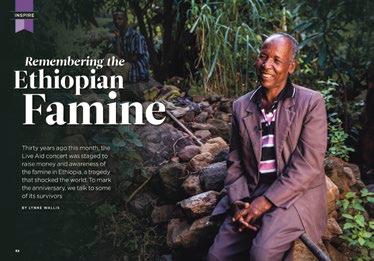
But reading the real-life stories in “Remembering the Ethiopian Famine” put our small offerings from the comfort of our homes into perspective. It’s heartening to hear that the people who survived have been able to turn their lives around and become successful.
Scrabbling for the food they received and seeing family members, friends and other people die must have left an indelible imprint on them. They have undergone things that no one should have to experience. It made for a very humbling read.
KEVIN BRIGGS, Scalloway
tho UG ht S of the Atre
What memories your “Best of British: Outdoor Theatres” article brought back. When I was a child, my parents and I used to holiday on the Roseland Penninsula. The dates are a little fuzzy, but one of our side trips was to the Minack Theatre. I believe it must have been sometime in the late
1950s. The play that evening was Shakespeare’s The Tempest. The whole atmosphere was dramatic: evening closing in, stars in the sky and waves crashing on the rocks below all enhanced the wonderful experience of the play. I have never forgotten how magical it was.
JENNIFER LANG, Gloucestershire
6 | 09•2015
C le A n SP e AKI n G
As a fan of James Brown’s “Reasons To Be Cheerful”, I loved his account of his toddler’s gradual acquisition of language. A child’s first words are generally cherished by proud parents, but I’ve yet to come across any as unusual as those spoken by my son.
He was sitting in his high chair watching me load the washing machine and suddenly came out with “Soap powder!”, which he repeated gleefully for the rest of the day.
MAGGIE COBBETT, Yorkshire
G olf I n G G r IP e S
Susannah Hickling stated in her health pages that golf is good for men’s health. I’d like to add that it isn’t very good for some women’s health when your partner is golf obsessed and—as well as playing several times a week—spends three days on the couch watching the Open from St Andrews on TV! The stress levels definitely soar.
CHRIS TAIT, Fareham
other l IVI n G B e I n GS
It was interesting to read about the Four Paws sanctuaries in “Saving Our Bears”. We don’t generally think of bears as helpless (quite the opposite),
and I enjoyed educating myself about this issue.
People like Carsten Hertwig are an inspiration to us all, and a reminder that we should care about other living beings too—not just ourselves.
ANN MICHAELS, Hove
t I me to Sto P G rU m B l I n G
I relished Michael Vaughan’s “If I Ruled the World” and agreed with every one of his sentiments, especially the one about wanting people to be more positive. Negative thoughts can easily cloud a path of thought, preventing a person from visualising a better outcome.
We could all take a moment to stop complaining and appreciate what we’ve got.
DAISY TRUBY, Hertfordshire
the C o U ntry for C omedy
Carl Donnelly was funny in “60Second Stand-Up”. My partner and I discovered comedy clubs six years ago and we’ve been regulars since. From local northern gigs to central hangouts in Soho, we’ve learned that each town has plenty of comedy to satisfy our laughter needs. Of course, some comedians/comediennes are better than others, but you support them all—it’s good to guffaw!
ANNABEL HAMMETT, Cheshire
WE WANT TO HEAR FROM YOU! Send letters to readersletters@readersdigest.co.uk Please include your full name, address, email and daytime phone number. We may edit letters and use them in all print and electronic media. 7 09•2015 |
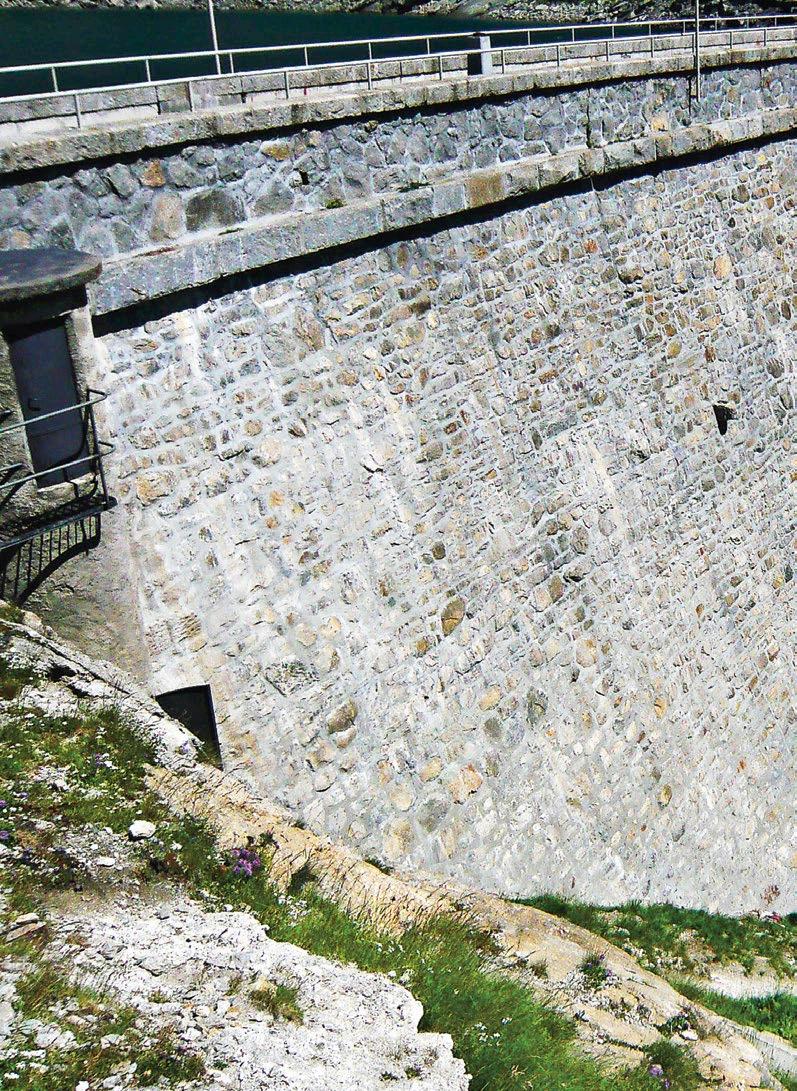
8

the world turn the page
see

... differently
Gravity is no match for these Alpine ibex goats. They typically live in very steep, rocky terrain—so this 160-foothigh, near-vertical dam in northern Italy doesn’t faze them as they roam, licking the stones for salt.
previous spread and this spread: adriano M i GL iorati /C aters

11
Rap aficionado James Brown discovers an unexpected bonus of parenthood
Like Father, Like Son

James, founder of Loaded magazine, now edits Sabotage Times—an online magazine with the motto: “We can’t concentrate, why should you?”
It’s 11.45 on a saturday n I ght and I’m waiting for my 14-year-old son Marlais to come back from his first gig. He’s been to see the legendary rap group Public Enemy, who are playing at the Roundhouse in London.
He’s not new to the scene. He’s been to festivals with me, hung around in Oasis’ dressing room, and watched the New York Dolls from the side of the stage when he was little. But this is the first time he’s gone with a friend, even though his friend’s dad went too. I’d have liked to have gone myself, but my mate sorting the tickets had gone off to Glastonbury and— rather unsurprisingly—it was impossible to get hold of him.
Never mind, I told myself. I actually interviewed Public Enemy three times early on in their career, when I was working for New Musical Express. One meeting was in Switzerland, another in London and a third in San Diego. I particularly remember that last time because I was knocked to the floor from the front row of seats—a hapless victim of the screaming teenage girls running to get hold of the band’s arch-prankster and timekeeper Flavour Flav.
Even before I’d met them, I’d reviewed their debut album Yo! Bum Rush The Show and absolutely loved it. A new sound using old sounds—an album that originated from radiostation jingles, raps and a call to arms. They were, like my namesake James Brown (the Godfather of Soul), cleverly playing with The Clash’s political sensibility.
Reasons to be chee R ful | 09•2015 12

It sort of amused me that Marlais was going to see them. He’s 14 and I’m 49, but here was something he’d discovered himself that I’d enjoyed myself decades ago. There’s a whole generation of kids learning about the
icons of rap from each other—not from their parents.
Just as I’m about to call his friend’s dad, I hear the gate hitting the bins and see them coming up the steps. I open the door, say thanks to the other
Reade R ’s d igest 09•2015 | 13
I e R
Illust R at I on by
Matthew bR az
The look in his eyes says it all. Positively beaming, he catches his breath before saying, “It was amazing. We left Finn’s dad up in the balcony and went downstairs, and told security our dad was inside and had our tickets. Then we went right down to the front. Flavour Flav jumped down and hi-fived me!”
I see in an instant that he’s just realised there’s a whole different world out there to the one he’s experienced already. There’s no holding back when Public Enemy play live—it’s bomb dropping, scratching, beats and rap that just carry you along. It’s truly inspirational. For a moment, I see the light in his eyes, and I recall the total and utter excitement I used to feel at live gigs when I was his age.
I see the light in his eyes, and I recall the total and utter excitement I used to feel at live gigs when I was his age getting
You never know what will happen adult for taking them, and notice how enthusiastic Marlais is in saying thank you and goodbye to his friend Finn. I close the door and ask the all-important question, “How was it?”
down to the venue—usually Leeds University Refectory or The Warehouse—waiting through the support act and then getting down the front, squashed in tight by leather jackets. I’d come alive when the main act came on.
An hour and a half of mayhem would follow— relentless, pounding music and the most vigorous thrashing around I could endure. By the end my clothes would be totally soaking and the ringing in my ears wouldn’t stop until the next day.
Somewhere I’ll still have the tickets for concerts by The Jam, The Ramones, Chuck Brown & The Soul Searchers… not to mention the fledgling U2 and Depeche Mode. As a teenager, the process was what I loved most of all: getting my ticket, waiting for the day,
one of the early joys of parenthood was realising I could once again walk through my own childhood as my first son discovered water pistols, Subbuteo and matchbox cars. In fact, there are so many opportunities to revisit where—or what—you’ve been before, but it hadn’t occurred to me that my eldest son would make his own tracks through a world I’d also adored. Skateboarding and computer games were his last big interests, and they seem to be as permanent as playing football in the street was for me. So to see this sudden enthusiasm for live music knocked me over. And I’m happy about that.
Reasons to be chee R ful | 09•2015 14
to your kids, but you hope they’ll achieve all they are capable of and have fun along the way. At present, the rules, boundaries and basic behaviour requirements of school seem beyond Marlais for a whole week at a time, so maybe something else will help direct him to where he’s meant to be.
Yesterday we walked into a bookshop and he asked for The Catcher In The Rye. “A teacher told me to read it,” he said. Just 24 hours later, he’s almost finished it. Like father, like son— bands, gigs and the spirit guide of J D Salinger are the life blood of young manhood. It can’t wait for all the great books and beats that lie ahead.
budding authors, take a bow!
This captivating, clever tale was one of thousands submitted to this year’s 100-Word-Story Competition. We’re publishing a commended story every month.
the mYsterious other
she was around before I knew him; I have seen her, on the edge of some of the early photos.
he loves me, but is attracted to her more. she has that hypnotic quality which binds them.
I accept all the excuses— “Just popping out, dear!” or, “need to make that important phone call.” or, “there’s no reception in this restaurant!” even during saturday afternoon shopping—“I’ll just wait outside till you are through.” she’s been in his car; I have smelt her heady, lingering perfume.
If I ask him to choose, will he choose me or lady nicotine?
Lorraine Worsley, Salford

Lorraine says: “As a former broadcaster, I’m used to making a few lines say a lot! I met my husband Bob when I interviewed him on my radio programme some years ago. At the time Bob was a 40-cigs-a-day man, while I’ve never smoked. He promised me that one day he’d give them up; it’s taken him 18 years but he did so over two years ago. I’m very proud of him. Although I’m new to storytelling, I’m currently in the process of writing my first book.”
Lorraine will receive a cheque for £50
Reade R ’s d igest 09•2015 | 15


Reader OfferRecommended DVD
First Time Ever on DVD


Released 14th September 2015

In this pacey, multilayered Norwegian crime drama, two teenagers with a secret life are caught in a web of murder, corruption and gang warfare.
How To Order
(Please quote RDP031 when ordering)
Online: shop.readersdigest.co.uk
Phone: 0844 332 8080 (8am-8pm Mon-Fri, 9am-5pm Sat-Sun)
By Post: Reader’s Digest, FREEPOST

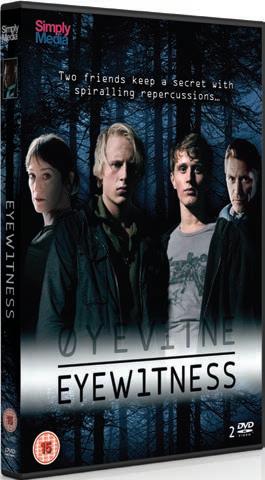
RTHR-LLRY-ZHYS, Ringwood, BH24 1HD (Cheques should be payable to Reader’s Digest, and please remember to quote RDP031 and include your full name and address, along with the details of the item(s) required). ONLY £12.99*





RRP: £24.99 DVD 6hrs * plus £1.99 p&p


MANY MORE NORDIC NOIR NEW RELEASE AND CLASSICS AVAILABLE Visit our website for details of the full range available shop.readersdigest.co.uk
Films
by tom browne
Movie of the Month

Double trouble: Tom Hardy as Reggie and Ronnie Kray
■ biopic: legend The notorious Kray twins, who ruled London’s East End in the 1960s, were given the bigscreen treatment in 1990, with the unlikely pairing of Gary and Martin Kemp from Spandau Ballet portraying the gangster brothers. This time round, the excellent Tom Hardy plays both the business-minded but brutal Reggie and the unpredictable, psychotic Ronnie. Much like previous gangster flicks such as The Godfather and Goodfellas, Legend excels at depicting a world of seedy glamour that can erupt without warning into violence. And like those earlier films, there are many supporting performances to savour, especially Christopher Eccleston (see interview on p20) as Detective Leonard “Nipper” Read and Emily Browning as Reggie’s disillusioned wife Frances.
■ drama: me and earl and the dying girl The title encompasses the main players in this charming indie flick. “Me and Earl” ( Thomas Mann and R J Cyler) are firm friends who make amateur versions of classic films, while the “dying girl” (Olivia Cooke) is a classmate whom they befriend after learning that she’s suffering from cancer. The tone switches —or lurches sometimes— from comedy to tragedy, but it tugs at the heartstrings.
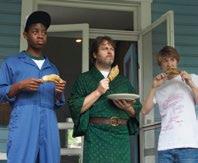
■ thriller: everest
The series of avalanches earlier this year highlighted the dangers associated with scaling the world’s highest mountain. This all-star thriller, headed by Jake Gyllenhaal, Keira Knightley, Josh Brolin and Emily Watson, is based on the 1996 Everest disaster, focusing on the survival attempts of two expedition groups. Expect plenty of frost-bitten drama and vertigo-inducing 3D.

entertainment 09•2015 | 17 © studio canal / © 20th century fox / © universal pictures

■ big budget: the martian Director Ridley Scott made his name with the futuristic classics Alien and Blade Runner, so this adaptation of Andy Weir’s sci-fi best-seller is highly anticipated. Matt Damon plays Mark Watney, an astronaut who draws on all his ingenuity to survive when he finds himself stranded on Mars. Kate Mara and Jessica Chastain also appear as two of his would-be rescuers.
■ adVenture: a Walk in the Woods Based on the 1998 memoir by Bill Bryson (played here by Robert Redford), this tells the story of Bryson’s attempt to hike the lengthy Appalachian Trail after returning to the US from Britain. But his plans are spoiled when he’s joined by his overbearing and underprepared friend Stephen (Nick Nolte). Emma Thompson also stars.
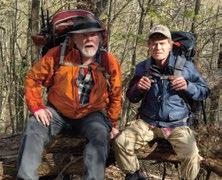
DVD of the month
■ girlhood
Riveting French drama about a girl who’s seduced into gang culture.*
On Your Radar Gloria Wilding, retired baker
Watching: spooks (dVd box set) This drama about MI5 agents used to be one of my favourite shows on TV.
Reading: a street Cat named Bob by James bowen A charming story about a recovering drug addict who finds a stray ginger tomcat.


Online: this is why i’m broke Gift ideas from across the web. I love the ingenious gadgets that people think up.
l istening: here you Come again by dolly parton I’ve been a fan for years and grew up with her music. Now I listen to her songs on my iPod.
Fancy appearing in this section? Send your current cultural favourites, along with short descriptions, to readersletters@readersdigest.co.uk
| 09•2015 18 entertainment
© 20th century fox / © entertainment one
* TO BUY DVDS FEATURED HERE, GO TO Shop.readerSdigeSt.co.uK
Music
by mandi goodier Album of the Month
E•MO•TION
by carly rae Jepsen
Although very much part of today’s pop revolution, Carly Rae Jepsen’s new album could easily sit in the tape deck of a 1980s American convertible. It’s a surprising direction for the singer associated with school-disco favourite “Call Me Maybe”. Although still comprised of songs about boys, E•MO•TION marks a transition from teenybopper to mature artist.

Title track “Emotion” is the most reminiscent of her pop background, but made cool through dream-pop synths, muted guitar and a funky drumbeat. Elsewhere, the songs are minimal—understated melodies lifted by catchy vocals that once again emphasise Jepsen’s mass appeal.
Key tracks: “Boy Problems”, “All That”, “Run Away With Me”
Like this? You may also like: Solange, FKA Twigs, Lorde
overlooked record from the past talk, talk, talk by the psychedelic Furs

Despite containing The Fur’s biggest hit “Pretty in Pink”, 1981’s Talk, Talk, Talk made little impact in the UK. (Although it fared better in the US, which perhaps said more about Britain’s tendency towards singles over albums.) Caught somewhere between punk, pop, new-wave and hard rock, the album encapsulates The Fur’s unique sound, where sax and guitar phase in and out, vying for attention with the snarling vocals. It’s primal and sexy until the climactic “All of This and Nothing”, a sensitive break-up ballad that lists a number of shared items, emptied of all former meaning.
On Our Radar
bo peep cider Festival, Sept 11–13, oxfordshire Sample over 100 beverages.
rugby world cup, Sept 18–oct 31
Twenty teams are competing, with the final at Twickenham.
baxters loch ness marathon, Sept 27, 10K and 5K runs amid stunning scenery.
Reade R ’s d igest 09•2015 | 19
liSTEn TO THESE AlBUmS AT readerSdigeSt.co.uK/liSten
The
Krays Man Who Nicked The
Actor Christopher Eccleston talks about his role as Detective “Nipper” Read in the new film Legend, and the part he played in bringing Britain’s most notorious criminals to book
 By tom B rowne
By tom B rowne
entertainment
20

when i say the name Christopher eccleston, what’s the first thing that springs to mind? If you’re under 30, it’s probably his acclaimed portrayal of Doctor Who in 2005, which introduced him to a whole new audience. Slightly older viewers may recall the earnest Nicky Hutchinson in the BBC’s eradefining Our Friends in the North. Others, meanwhile, will mention his disturbing turn in the cultclassic thriller Shallow Grave.
Three roles, all acclaimed, all entirely different. It’s fair to say that Eccleston has never been an actor in danger of typecasting.
The real seriousness of purpose behind his choices is easy to see— one thinks of Jimmy McGovern’s hard-hitting Hillsborough, or the wonderful Thomas Hardy adaptation Jude, where he starred alongside Kate Winslet. But his career has been diverse enough to encompass everything from John Lennon to Gone in 60 Seconds, and when I tell him I’ve been cast as a zombie in a local stage production, he willingly gives me some pointers. (“You’ll have to locate within yourself and within the zombie some part that’s still human”—thanks, Chris.)
“In terms of the things I’ve felt have been successful and I’ve enjoyed

doing, it’s all about the quality of writing,” he says when I ask about the thread that ties his roles together. “I grew up in an era of British TV where the focus was on the scripts— ones that are alive to the ambiguity of character and the contradictory nature of human beings.”
this is just as well, as it’s hard to imagine a more rich and vibrant movie in terms of character than
THE MAN WHO NICKED THE KRAYS | 09•2015
© p RE v IO u S IMA g E : g ETTY IMA g ES /M ARK Cu THBERT 22
Christopher Eccleston on the set of Legend in East London; (right) Tom Hardy as the Krays

.
Eccleston plays a supporting role in the film, which is very much a showcase for co-star Tom Hardy; he portrays both Kray twins— the crime leaders who terrorised London’s East End in the 1950s and 1960s—and you quickly forget that it’s one actor playing two roles. After

all, there’s a world of difference between the violent but reasonably grounded Reggie and the totally unhinged Ronnie, who was declared insane after his imprisonment in
23 09•2015 |
Legend, a new biopic based on John Pearson’s book The Profession of Violence: The Rise and Fall of the Kray Twins
© WENN LTD /A LAMY / © ST u DIO CANAL
THE MAN WHO NICKED THE KRAYS

Christopher was the first to bring Doctor Who back to life for a new generation in 2005
1969 and spent the rest of his life in Broadmoor Hospital.
“The boldness of [Tom Hardy’s] characterisations and their differences are pretty extraordinary,” agrees Eccleston. “I worked with him first as Reggie, and then towards the end I had a scene with Ronnie. Reggie was a pretty conventional, predictable individual, but Ronnie… well, Tom made decisions there about the level of his eccentricity that were fascinating.
“On a psychological level, the Krays were very interesting. I myself have identical twin brothers, eight years older than me, so I know how extraordinary that relationship can be. Fortunately, my siblings were far more positive!”
Eccleston plays the small but pivotal role of Detective Chief Inspector Leonard “Nipper” Read in the film, a man who looms large in
“aCting was a huge esCape for me”
1988: Makes stage debut in the Bristol Old vic’s production of A Streetcar Named Desire.
1991: Comes to public attention as Derek Bentley—who was controversially hanged for murder in 1953—in the film Let Him Have It
1994: Appears in the low-budget thriller Shallow Grave, which
launches the careers of Ewan
Mcgregor and future Oscarwinning director Danny Boyle.
1996: plays the lead character
Nicky Hutchinson in the BBC drama Our Friends in the North, which makes him a household name.
1996: portrays Trevor Hicks, who lost both his daughters in the 1989
24 | 09•2015
© J OHN R O g ERS
the history of the Metropolitan Police. As well as pursuing gangsters—he titled his autobiography Nipper Read: The Man Who Nicked the Krays he also targeted rock stars such as The Beatles and The Rolling Stones.
“I think he was present on the day Marianne Faithful, a Mars Bar and a blanket were first revealed to the world,” says Eccleston with a laugh, referring to an infamous incident in 1966 during which a drug search at Keith Richards’ home uncovered Mick Jagger’s girlfriend naked and draped in a fur rug (the role of the Mars Bar has been a source of fruitful speculation).
THEY WERE VILE CRIMINALS. I’M DISMAYED BY THE WAY THEY’RE ROMANTICISED
in Legend is someone who feels completely out of step with the Swinging Sixties. “He’s a man resisting all this excess, fluidity and change with every inch of his will. This is someone formed in the 1930s and 1940s in working-class Nottingham, and wants things to remain that way. When I first read a draft of the script, I told [writer and director] Brian Helgeland that Nipper brought to mind Malvolio from Shakespeare’s Twelfth Night, who’s a very puritanical and self-righteous figure.”
Indeed, continues Eccleston, the version of “Nipper” Read portrayed
Hillsborough disaster, in Jimmy Mcgovern’s Tv drama Hillsborough Eccleston is best man at Trevor’s wedding in 2009.
1996–2002: Appears in a number of high-profile film roles, including Jude, Gone in 60 Seconds, The Others, 24 Hour Party People and 28 Days Later.
2005: Cast as Doctor Who in the BBC’s massively successful reboot,
Despite this, Read comes across sympathetically, with Eccleston successfully channelling a sense of righteous fury. And while it’s easy to mock the old-fashioned values that
but only stays for one series, stating he didn’t enjoy the working “culture”.
2010: portrays John Lennon in the BBC’s Lennon Naked, covering the Beatle’s life from 1967 to 1971.
2013: Appears as the evil Malekith in Thor: The Dark World, the sequel to 2011’s Thor.
2015: plays Detective Leonard “Nipper” Read in Legend
Reade R ’s d igest 25 09•2015 |
THE MAN WHO NICKED THE KRAYS
he represents, there’s been a corresponding tendency in some quarters to glamorise the seedy criminal underworld of 1960s London—and even the Krays themselves. It’s a tendency that Eccleston deplores.
“They were vile criminals, in my view,” he says emphatically. “I’m dismayed at the way they’re romanticised by some. I mean, it’s all just nonsense: ‘They were good to kids and they were good to their mum.’
Yes, and they murdered and slashed and burned. There’s no ambiguity for me, and there’s no ambiguity for Nipper in the film.”
of the locals won’t give him any information and cover up for the Krays instead.”
Is this a case of inverted snobbery? “Yes—it’s a class thing, to a certain extent. But I just think it’s b******s whenever anybody starts romanticising the other side of the tracks.”


In fact, says Eccleston, Read’s own working-class roots make him even less receptive to the mythology of the twins. “I think Nipper felt—as I would feel—a great deal of shame that they were using their class as justification for their activities. And he expresses his dismay when some
ecclestone’s pride in his own workingclass identity is obvious during these exchanges. He speaks warmly of his early years in Salford and his relationship with his parents. “My father was quite a literary man, and both of them encouraged me to read a huge amount. Looking back on my acting career, I notice there are many father-son relationships—Our Friends in the North comes to mind. Lots of men in conflict with their fathers, which I never was in real life; there was a deep love between us.”
26
| 09•2015
© J OHN J E ff ORD / © uNITED A RCHI v ES gMB H/A LAMY
Christopher and Daniel Craig in the BBC drama Our Friends in the North
Alongside Kerry Fox (centre) and Ewan McGregor (right) in Shallow Grave
Inspired by kitchen-sink dramas such as Kes and Saturday Night, Sunday Morning, Eccleston trained at the Central School of Speech and Drama and made his stage debut at the age of 25. For all that, the path to stardom wasn’t smooth, with a number of years between roles working on building sites and in supermarkets. And—as Eccleston is keen to point out at the end of our discussion—things are far harder for poorer kids today.
“Acting was a huge escape for me. But nowadays, if you’re from my background, the door is almost shut. All the classical roles in London’s
West End go to white, middle-class males, and we get a culture that’s resultantly bland. To be honest, I find it very disturbing.
“I like to feel that I’ve given as much to the culture as it has to me, but it’s getting much worse—nobody can argue with that. We have to keep up a dialogue about it and we have to keep up the pressure.”
Legend is released in cinemas this month. You can hear an audio version of this interview at readersdigest.co.uk/ podcast. And for DVDs featuring Christopher Eccleston, including the best-selling Our Friends in the North, go to shop.readersdigest.co.uk
L OST f O r w O r DS
Despite boasting more than a million words, there are some things that just can’t be expressed in the English language.
Lagom (Swedish): Referring to the etiquette of taking your share, it means neither too much nor too little.
Culacinno (Italian): The mark left on a table by a cold glass of water.
Pena ajena (Spanish): The feeling of being embarrassed for another.
Komorebi (Japanese): The interplay of light and leaves when the sun shines through trees.
Pochemuchka (Russian): Someone who asks a lot of questions.
Pana po’o (Hawaiian): Scratching one’s head to remember something.
Reade R ’s d igest 09•2015 | | 27
HuffINGTONPOST.COM
SOurCE:
Do You Crave Companionship?
There’s a lot to consider when seeking the perfect companion, but help is at hand with Reader’s Digest Dating.
Open to the large number of Reader’s Digest users, the website is live at www.readersdigestdating.co.uk
THE USER-FRIENDLY WEBSITE BRINGS COMPANIONS TOGETHER
by allowing them to match with potential partners according to their hobbies and interests. It’s free and simple to sign up for Reader’s Digest Dating and the only cost involved is using the website, which is a very affordable membership fee.
The three-step sign-up process is straightforward, and the website is a safe and welcoming place for age-appropriate singles to meet likeminded individuals. Movie aficionados, news buffs, travel lovers and interior

design enthusiasts will all find someone to spend time with.
Who Is The Website For?
Aimed at single people over the age of 40, Reader’s Digest Dating is all about matching individuals who have similar life goals. The dating website has plenty of users who are avid readers, cooking fanatics, motoring enthusiasts and shopaholics—truly, there is someone for everyone.
Does Online Dating Work?
It’s believed that one in five UK
ADVERTISEMENT FEATURE

relationships now have their roots in online dating.
Online dating is a particularly good way to meet new people for individuals who can be shy in social situations, as it provides a safe space in which to look for a partner. Chatting in advance of meeting can help bonds and connections to be formed as well.
A Safe Environment
Safety is key at Reader’s Digest Dating, which aims to provide a reliable and reassuring space for people to talk about their interests and find companions.
Users are able to browse at their own pace. Online dating can be daunting for those taking their first steps into this world, but the website provides a safe and encouraging environment in which to begin.
Why Reader’s Digest Dating Is Different
Unlike most dating websites, the website has a clear focus on companionship. The goal is to match people who have similar interests in life and will enjoy spending quality time together.
The dating website is accessible from the Reader’s Digest website and will have a similar feel to the main site, so regular visitors will immediately feel right at home. Browse for free today at www.
readersdigest dating.co.uk and start chatting right away.
Midge Ure, 61, co-wrote the 1984 charity single “Do They Know it’s Christmas?” with bob Geldof. He’s currently performing in a nationwide tour
Midge Ure
“I Remember”
…Being in a pram and seeing a sign swinging in the win d above my head. I was born in a tenement in Cambuslang, on the outskirts of Glasgow, so my mother would have to take me out all the time. There was no way you could stay in that tiny little flat all day.

my parents while my brother and I shared the bedroom. It was very cold, very damp and [had] the smell of paraffin oil, which we used to supplement the heat from the fire, only in the winter. So to this day, the smell of paraffin oil reminds me of the build-up to Christmas. To me, it was great.
…Life was pretty toug h . We had an outside toilet, a scullery, a sink by a window and a fireplace. Opposite the sink was a cavity bed, which was a recess in the wall with a mattress on that my parents used to sleep in. It was tight, especially when my sister came along—she slept in the cavity bed with
… m y father Jimmy was a van driver. He worked particularly long hours driving for a bakery. My mother Bet was at that time a stay-at-home mum—housework seemed to be the thing that consumed her life, just looking after us. We didn’t really have an awful lot, but what we had was each
| 09•2015
© Simon n ewbury/Al A my 30 entertainment
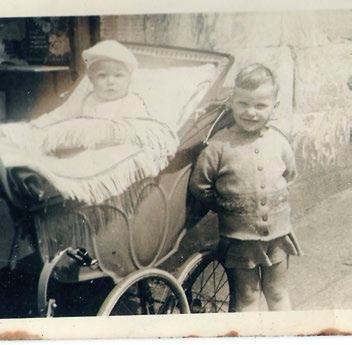
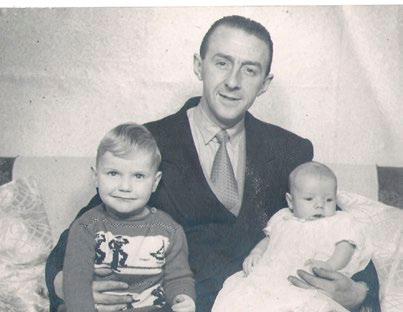
 Midge with his older brother and uncle George. “We didn’t have a lot, but what we had was each other”
Midge with his older brother and uncle George. “We didn’t have a lot, but what we had was each other”
Left to right: Midge, his dad, mum, sister (Linda) and brother (Bobby)
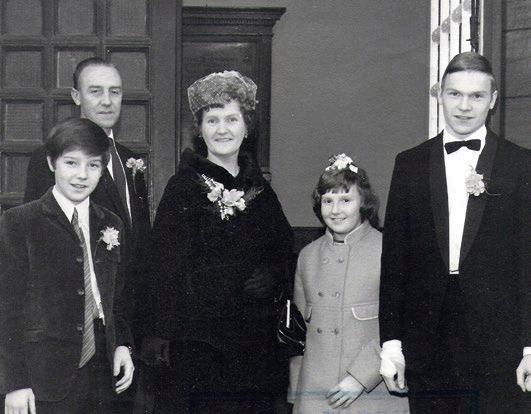
other and that was an incredibly important thing.
… a t Cam B us L ang p rimary
sChooL , the one outstanding person was a teacher from the Highlands—a lady called Miss Gebbie. I wasn’t academic at all, but I could draw and paint and could always sing. I loved this lady. I thought she was wonderful, and because she was young she was completely different from all these other big, Victorian-esque schoolmarms who were quite stoic and very Scottish and a bit violent. Even if you were six or seven, they wouldn’t think twice about giving you the strap on your hand if you spoke in class or did anything supposedly wrong. Miss Gebbie was kind, and quite possibly a kindred spirit—she
was artistic, she could paint and draw. It was wonderful because she really took time with me.
… annoyan C e that no B ody ever suggested to me that if i did we LL at s C hoo L , I could quite possibly go to the Glasgow School of Art. It was just decided somewhere, very early on, that I wasn’t academic material and would end up in a factory. I was about ten, heading up to secondary school, and I think it was just accepted that that’s what you were. It was only the top ten per cent that would end up going to university—it was such an elite thing. Everyone else just set off to work in shops or factories, or drive vans like my father did. My parents instilled in my brother and me that we should try and get ourselves a skill—an apprenticeship as an engingeer, electrician or plumber.
…Leaving s C hoo L at 15. I hated it. I couldn’t stand the fact that I was a square peg in a round hole and being forced into doing something that I wasn’t cut out to do. At this point, I was already playing music and had taught myself guitar. I left school and attended
I remember 32 | 09•2015
© Previou S im AG e A n D P er S on A l PH o T o S C our T e S y of mi DG e ure
engineering college for six months, and then went for an apprenticeship at the National Engineering Laboratories on the outskirts of Glasgow. After two years, I ended up leaving to join a band full-time at 18.
My father was horrified because here was the son who’d been told his entire life he was fantastically “adequate”—or possibly inadequate—and not wellequipped for life at all. I’d got the job of their dreams and here I was, about to leave it and join a band and have this incredibly flaky career. But my mother—she ruled the roost, she was a feisty old character—just said, “Follow your heart, you’ve got to do what you think is right,” which was a hugely adventurous thing for her to say, and a bold thing for her to let me do.
… i n the ear L y 1970s, any Career in musiC in sCotL and was a B it of a pipe dream. Everything was so London-centric, so if you were trying to become successful or were hoping to be spotted and signed by a record label, it really wasn’t going to happen in Scotland. But then, ironically, I suppose it did. I was spotted by this guy
called Bill Martin, who was a songwriter and producer, along with his partner Phil Coulter. Those guys were like the Stock Aitken Waterman of their day—they were writing songs for The Bay City Rollers. Bill Martin happened to hear the band I was in at the time, Slik, performing live at a venue in Glasgow and he couldn’t believe that this young band were making that noise. He signed us to his record label.
… a fter B reaking the C ontra C t to get away from the teeny B op B u BBL egum thing, I got a phone call from a guy I’d never met before, Glen Matlock, who was the original bass player for the Sex Pistols. Glen had been talking to a

Reade R ’s d igest 33 09•2015 |
T y m
m
P
A
© Trini
irror/
irror
ix/Al
my
Midge (second left) in Slik

music journalist who was a writer for the magazine Melody Maker. This journalist had suggested that I would be the perfect person to join Glen’s new band The Rich Kids, and they called me up while I was still living in Glasgow and said, “Would you come down to London and do a rehearsal with the band?” It was a phone call from heaven for me.

… w hen i was in uLtravox, we wanted “Vienna” to come out as a single because it was so uncommercial and so different from everything else around at the time. The record company wanted
to edit the track down because it was too long for the radio, but we insisted that if it was coming out, it should only come out in its entirety. So we eventually knuckled down and they let us release this four-minute-long track. It could quite easily have disappeared, but I think there was something unique about it that just touched people, and it went the other way. All of a sudden, Ultravox were elevated to a much higher stature as a band, playing regular and much larger concerts. We toured the world. It was just the most glorious sensation ever. was making a soLo aLBum in 1984 when I got the phone call from Bob Geldof about Band Aid, and that changed everything again. I was on music programme The Tube , which was co-hosted by Paula Yates—Bob’s girlfriend at the time. I was chatting to Paula in her dressing room when Bob called and said, “Let me speak to Midge.” He told me he’d just seen the first news footage of the famine in Ethiopia on the BBC and said, “I’m disgusted and I want to do something. The Boomtown Rats has gone and I’m
34 | 09•2015
© Pi CT ori A l Pre SS lTD /Al A my / © C bw /Al A my
Midge (second left) found international success with Ultravox in the early 1980s
not in a position of power. Will you help me put something together?”
… d e C iding that if we C ou L d have a Christmas num B er one, then we could possibly generate £100,000. So we had to write something and then donate the money that the writers would usually get to Ethiopia. If we could use the talents and kudos of our friends to get it to number one in the charts before Christmas— the charts freeze over the Christmas/ New Year period—that would generate more money than at any other time of the year.
So it was quite a cold and calculating thing that we did. By the time we got to the day that everyone saw [in the video], with all the artists, we’d knocked together the idea of how this was going to be. We’d come up with the name, Band Aid, we had the artists on board, we had the studio lined up in London. The media had already grasped what we were trying to do.
… at eight o’ CL o C k in the morning, Bob took a cassette to BBC Radio One and gave it to Simon Bates, who was doing the breakfast show. I was driving home in my car and was listening to the radio, when I heard the song being played on cassette for the first
time ever. The moment it finished, they rewound it and they played it again. That was unheard of—Radio One don’t play cassettes and they don’t play the same song back-toback. So at that moment I knew that something amazing was happening. At the time, it raised around £7m. With Band Aid and Live Aid, it’s raised in the region of £150m.
…t he downside of Band a id was that it kind of finished my band. I was a very different person—quite
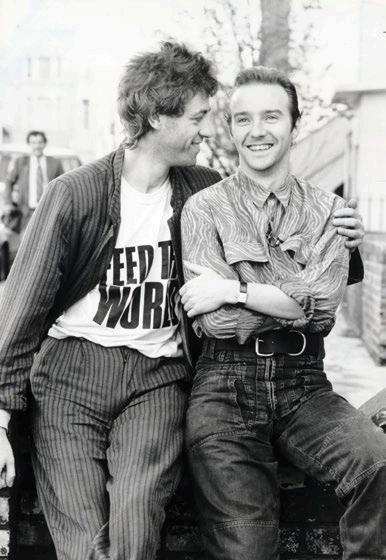
Reade R ’s d igest 35 09•2015 |
© D A vi D Crum P /C H ri S bA r HA m/D A ily mA il/ rex
Bob Geldof (left) and Midge Ure formed Band Aid with a “cold and calculating” approach
Midge was “a bit proud” to receive his OBE, accompanied by wife Sheridan (right) and four daughters
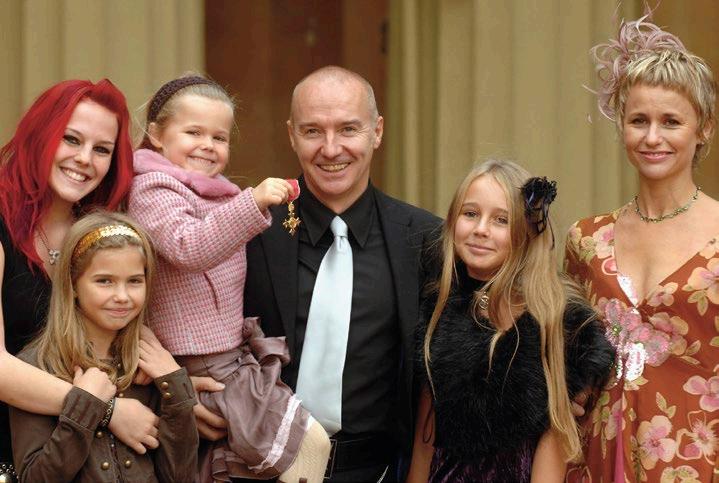
possibly a better person for having done it. I’m a musician from the outskirts of Glasgow; I wasn’t cut out to go to aid camps on the outskirts of Addis Ababa. But I did it because I realised that if Bob or I or any other musician didn’t go, the media wouldn’t go.
It was a bizarre experience, shall we say, and a very humbling one. You’ve seen various images on TV—you’ve been seeing this stuff for months, but I suppose you’re not prepared for the taste and the smell, for all the other senses kicking in. It’s quite shocking. And you come home with a huge admiration for people working out there, who dedicate their lives to dealing with those extreme conditions.
… k idding myse L f that a LC ohoL is an aid to Creativity. Of course, it’s a crutch. Like all these things, it made me taller and more handsome and infinitely more funny —I thought—but it just makes you boring. I had very good, strong family around me who pointed this out and helped me through the process. You have to decide to turn off that madness in your head and get on with life, which I did about ten years ago.
…when my parents were Both a L ive, the ultimate accolade they could understand was when This Is Your Life happened to me in 2001. Because something they’d known all
I remember 36
| 09•2015
© b ri A n Smi TH / rex
part of my life has been about music and still is. It’s like all the recognition you didn’t get at school all rolled into one. And the Queen pinning something to your lapel...well, that’s just wonderful. I was in a kilt and it was lovely. Nerve-wracking really, because it’s a bit like being called up in front of the headmaster—for something good for a change. It’s all pomp and circumstance and you’re feeling full of yourself, a bit proud—thinking of those Victorian teachers that used to give you the strap for being useless. You can’t help but think, Now they would see things slightly differently. As told to Joy Persaud their lives superseded all gold and platinum discs and all of that stuff. My father wasn’t well, but they sent a car and a nurse to bring both my parents up from Devon, where they were living, and it was great. It was a lovely event —it’s the big party that you always thought you’d organise but never got round to, and they’d organised it all for me.
…the five honorary do C torates i got [for Charity work] were the only ones I was ever going to get. I was never going to get a degree, so they were lovely things to have and it was the ultimate pat on the back, I suppose. But I was pleased that the OBE I got was for services to music. That was important to me—a major
midge is touring with his Breathe again show. For details, visit midgeure.co.uk
ti PS a BOU t t OW n
one witty prankster put up posters doling out dubious life advice all around his neighbourhood.
in the supermarket “unload your feelings on the lady giving out the cheese samples. it’s like a free therapy session; she’s stuck here and can’t leave while you cry.”
in the hairdressers “Try hiding m&ms and other small gifts in your hair so the hairdresser earns little rewards along the way.”
in the restaurant “exit the loo on a date completely wrapped in toilet paper and say, ‘we have so much in Tutan-common.’ ”
SOUrce: SaDanDUSeLeSS.cOm
Reade R ’s d igest 09•2015 | 37
FOR MORE, GO TO reaDerSDiGeSt.cO.UK/entertainment
US vs S Uper b Ug S
For the world’s cleverest microbiologists, it’s a deadly game of poker that can never end
By Lis A Fi TTE rm A n
HEALTH 38
Photo: ©Jose Luis Pe L aez/G ett Y i M a G es

They move by air and by T ouch, through the sting of a mosquito, a sneeze, a surgical incision or badlywashed hands. They sneak down your throat, up a nostril or into a sore, where they may cause fever, pneumonia, organ failure, joint pain and even death. Bacteria and viruses will still be here when we are no more—shifting, mutating and over time becoming resistant to whatever modern medicine throws at them.
Flu shots that worked one year are not as successful the next. Tourists to the Arabian Peninsula are suddenly warned about Middle East Respiratory Syndrome (MERS), a version of the ever-changing coronavirus first identified in Saudi Arabia in 2012. Many who contract it require mechanical ventilation as they fight for their lives. Chikungunya, a mosquito-spread virus causing joint pain—sometimes for life—was once thought to be limited to equatorial Africa. Now it’s spreading fast in temperate climates throughout the world.
Antibiotics have been abused for years, prescribed for everything, including colds and other viruses they won’t work on. Even when they’re used properly—for a urinary tract infection, for example—they still don’t destroy every bacterium they target. This is where it gets scary: once bacteria thwart one antibiotic, they soon learn to resist another and another until they become superbugs.
“The spread of superbugs is like the
spread of the flu virus: slower, over ten to 20 years, but relentless,” says Herman Goossens, a microbiologist at the University of Antwerp who chairs the joint programming initiative on antimicrobial resistance, in which 19 European countries have joined forces to coordinate research and data on the phenomenon.
Read on to find out more about some of the bacteria and viruses that have specialists desperately searching for solutions. While he Was sleeping
In March last year, Juan David Díaz Valenzuela had been in an induced coma for 60 days as his thin, weak body battled the effects of severe pancreatitis. Some time during the fifth week, klebsiella pneumoniae bacteria burrowed their way into his body, most likely through his tracheotomy tube.
Of all the bugs that have developed resistance to current medications, it’s bacteria such as klebsiella pneumoniae that worry specialists most. It’s a so-called “gram-negative” bacterium, one that lurks in the gut, is transferred via the hands of those infected and attacks the most vulnerable: people with compromised immune systems, diabetics and those with chronic lung disease. The effect can be catastrophic, from bloody sputum to organs that shut down—and death.
Only 39, Díaz Valenzuela had been put under in the intensive care unit at
T | 09•2015 40 su P e RB u G s vs us
the Reina Sofía hospital in Córdoba, Spain. The family of the married father of two were only told about the bacteria when he had to be moved to another hospital department dealing with similar infections.
He knows he’s lucky to be alive today. “Two cases—me and another man—survived this outbreak,” he says. “The other patients who were infected died.” He’s also angry. “My life has changed completely, from having a normal job to not knowing if I can ever go back to work.”
While hand-hygiene campaigns in much of Europe have proven successful when it comes to “gram-positive’” or staph infections (caused by the bacterium Staphylococcus), they haven’t made a whit of difference to the occurrence of stomach bugs. That’s why there’s a need for both rapid diagnostic tests to screen people coming across borders and new antibiotics, which will take years to develop.
“Basically, we need huge investment in Asia to clean up the sewage, purify the drinking water and
michael went to the hospital. What happened next remains jumbled and indistinct—memories framed by fever and hot pain
Microbiologist Goossens says he’s worried about countries such as Greece, Italy, Spain and Portugal, “where patients are dying and hospitals aren’t reporting the deaths because they are ashamed of their conduct”.
Right now, “k-pneumonia” is treated with a class of antibiotics called carbapenums, but Goossens notes the percentage of carbapnumresistant cases in the European Union is increasing, especially in the southern countries.
“You might have said, ‘Who cares? It’s limited to places to Asia,’ but it’s not. Not any more,” says Goossens. “People travel.”
generally improve hygiene at the source,” Goossens says.
The sprou T s did i T
At first, Michael Frotscher thought nothing of it. A neuroscientist at the University of Hamburg, he figured the diarrhoea would simply go away. Then the blood came, and reports of people infected with a particularly virulent strain of drug-resistant Escherichia coli, including 12 colleagues who had been with him at an annual departmental retreat.
“Go to the hospital,” friends and relatives advised him. “Please.”
He did. What happened next—and
09•2015 | 41 rEA d E r’s d ig E s T
very quickly—is a jumbled slideshow of indistinct memories framed by fever and red-hot pain.
A solicitous nurse bending over him, fixing his pillow. Needles and intravenous bags. White-coated doctors huddled by his bed, conferring.
It was May 2011. Michael was 64, tall and lean. He was planning to run the Berlin Marathon in September. Now, he was one of 4,075 people
the wrong time. It could happen to anybody, anywhere.”
“In Europe, there are things to be concerned about, such as [strains of] E.coli that are pan-resistant,” says Dr Timothy Walsh, a professor in the University of Cardiff’s institute of infection and immunity. “It’s a very common bacteria. You can have E.coli that is not particularly aggressive and E.coli that is highly virulent.”
Bas’ weakened immune system made him a target for mrsA, a notorious antibiotic-resistant infection contracted in healthcare situations
affected by this outbreak, which originated in sprouts from a nearby organic farm contaminated with a deadly shiga-toxin-producing E.coli strain.
E.coli itself has been around forever and most strains don’t cause any harm to humans. In this case, 50 people died. As a doctor, Michael knows exactly how close he came to being among that number. Later, he’d learn that he’d been put in a coma for five days because his kidneys were failing. That he was given an antibody that hadn’t been through all the trials yet because there was no other choice. He had a central nervous system infection. And he survived.
“It was a unique situation,” he says. “I was simply in the wrong place at
You have a superbug
Bas Jonker can’t think of one low point. Rather, he thinks of a series of them. The afternoon three years ago that doctors informed the financial officer from Leidschendam, a town near The Hague in the south of Holland, that he had acute lymphoblastic leukemia. Having to give up his motorbike because his hips were removed due to bone necrosis and he was confined to a wheelchair. The day his wife left after 12 years together because caring for him got to be too much.
And then in August last year, after four months when everything seemed to be going well health-wise, he tested positive for methicillin-resistant Staphylococcus aureus, or MRSA,
| 09•2015 42 su P e RB u G s vs us
the most notorious cause of antibiotic-resistant infections contracted in healthcare situations around the world.
With an immune system weakened by the treatments for his leukemia, Bas, 33, thin, with a sparse beard, has endured several treatments with new, stronger antibiotics to stave off the possibility of a blood infection from the MRSA. They made him very nauseated, and Bas was relieved to hear from doctors in March that, after seven months, he was finally clear of MRSA.
One in every hundred Europeans is thought to be a MRSA carrier, but most will never know a sick day due to a staph infection. Like C.difficile, it affects hospital patients who are on high or protracted doses of antibiotics, thus killing healthy flora in their guts and allowing the bacteria to grow. For MRSA, the risk comes when, like Bas, you have a weakened immune system; if you have a urinary catheter or IV line; if you suffer a cut while playing a contact sport, or live or work in a communal environment such as a military training camp. In all these circumstances, you’re at risk of developing an infection that could potentially kill you.

A culture of the potentially deadly Escherichia coli
Stephan Harbarth, an infectious disease specialist at the University of
Geneva, says that in Europe, at least, MRSA was once much more rampant than it is now. Years of campaigns to promote hand hygiene in hospitals in places such as Germany, Switzerland, UK, France and Scandinavia have played a role in bringing it under control, as has a more judicious use of antibiotics and faster diagnostic tests.
“I think this good trend will continue but I don’t want to say things are fine everywhere,” says Harbarth. “If I have to be in hospital, for example, I want it to be somewhere like Switzerland or Scandinavia—not Greece, even for a single day!”
09•2015 | 43
Y i M
G
Photo: © G ett
a
es
re M e M ber T he bug spraY
Soon after Fabien Duquenne, 50, and his wife, Nadine, 52, arrived from France at the little cottage they had booked in Guadeloupe for a holiday in May last year, the owner informed them that her three-year-old son had contracted something called Chikungunya, having been bitten by a mosquito the week before.
“Chikun-what?” Fabien asked.
“My son is getting better but it’s best that you always use insect repellant. You don’t want to get sick.”
It was the first time that Fabien, a manager in the Conseil du Nord in
sity Centre Hospital in La Réunion, a French Island in the Indian Ocean, and a visiting professor at the University of Bordeaux.
Chikungunya spreads quickly. In 2005–2006, more than 272,000 people in La Réunion (38 per cent of the population) were infected with the virus. During an outbreak in the Caribbean last year, 113 people died and thousands more were infected.
At first the Duquennes weren’t worried. They’d brought insect spray. They took precautions. Then, after three weeks, both were bitten and they started to have symptoms.
Fabien’s chikungunya symptoms come back regularly. “it hurts, when i can’t kick a football around with my grandson,” he says
Lille, and Nadine, who worked for the city, had heard of the disease that was first discovered in Tanzania in 1952. Why should they? Until recently, outbreaks were mostly limited to Africa and Asia. Now Italy, the Caribbean, Brazil and the US state of Florida are just a few of the places where tiger mosquitoes carrying variations of the Chikungunya virus have turned up.
“In Africa, ‘chic’ was not known to kill its victims. Now, some are dying,” says Bernard-Alex Gauzère, a tropical disease specialist at the Univer-
“The first thing I felt was a headache and I felt feverish, like I had the flu,” says Fabien.
When they walked into the waiting room of the local doctor’s surgery, a harried receptionist suggested they go to the local pharmacist, who said: “All I can give you is aspirin.”
“Let’s go home,” said Fabien.
Back in France, they were sent to the Lille offices of the Institut Pasteur, an international research organisation that specialises in areas such as microbiology and infectious diseases.
| 09•2015 44 su P e RB u G s vs us
Still, physicians could only screen their blood to determine the progress of the virus in their bodies and prescribe anti-inflammatories to calm the symptoms.
While Nadine has recovered, Fabien’s symptoms, especially the joint pain, come back on regular basis. He takes aspirin or anti-inflammatories to manage the pain and wishes for a time when he could do things he took for granted, such as hop on a bike, tie his shoelaces or pull up his socks.
“It hurts,” he says, “when I can’t kick a football around with my grandson.”
Gauzère says a search for a vaccine has been ongoing for 20 years but so far to no avail. “It takes time,” he says. “What we need to do right now is to stop the mosquitos from breeding.”
i s T here good ne W s?
Yes, say specialists, at least when it comes to Europe. Pharmaceutical research promises stronger versions of current antibiotics between two to five years down the road, and procedures such as a faecal transplant, one
of which was performed two years ago on an 86-year-old woman in Brittany, have proved an effective way to cure even the most persistent cases of C. difficile infection.
Successful hygiene campaigns in Western Europe have resulted in fewer cases of infections such as MRSA and C.difficile, says Harbarth. And there has been progress in the development of diagnostic procedures so that doctors know what they’re dealing with, without having to wait several days for lab results.
In places like La Réunion, experts are working on ways to curtail mosquitoes’ breeding and maybe one day there will be a vaccination to protect us from Chikungunya.
“Let’s say I’m cautiously optimistic for the next five to ten years,” Harbarth says. “Think of it this way: more patients will die from car accidents than superbugs during that time.
“But if you ask me what bugs will be around in 2030? That’s difficult to predict. When you specialise in infectious diseases, you’re facing an enemy much smarter than we are.”
did y OU K n OW?
in physics and chemistry, a “jiffy” is equal to about 33.3564 picoseconds. this means that if you’re really going to “be there in a jiffy”, you’d have to travel one centimetre faster than the speed of light.
sOUrCE: TOdAyiFOUndOUT.COm
09•2015 | 45
Health worries on your mind?
SOME OF THE BIGGEST WORRIES WE ALL FACE ARE WHEN IT COMES TO OUR HEALTH. While the NHS is the backbone of the UK’s health service, in the last quarter of 2014, the size of the NHS waiting list reached 1.76m — an 8.3% increase over the same period the previous year.*
So if you’ve never considered private healthcare insurance, perhaps now is a good time. e benefits of having private healthcare cover mean that if you’re worried about your health, and your GP refers you to a specialist, you can avoid the NHS waiting list for all eligible treatments covered by your plan.
Choosing a private healthcare insurance provider, who will give you all the reassurances you need, can be a bit of a minefield. at’s why Reader’s Digest have chosen AXA PPP healthcare to provide healthcare insurance to our readers.
Of course the main advantages of private healthcare insurance are access

to a speedy diagnosis and prompt treatment. However, many people are worried about specific conditions such as heart disease and cancer.
AXA PPP healthcare’s new plan, Personal Health, offers marketleading heart and cancer cover and care as standard. is means that you have access to the latest treatments, including licensed cancer drugs that are not available on the NHS.
ADVERTISEMENT FEATURE

AXA PPP healthcare also offers its Fast Track Appointments service, when you choose the out-patient option. at is because they can offer you access to over 250 private hospitals and 24,000 specialists.
*www.gov.uk, Monitor: ‘Quarterly report on the performance of the NHS foundation trust sector: year ended 31 March 2015’ (2015)
READER’S OFFER
Reader’s Digest are introducing customers to AXA PPP healthcare to provide affordable private healthcare insurance to readers. To find out more on what is and isn’t covered please visit www. readersdigest.co.uk/phi or call AXA PPP healthcare on 0800 5870 835.
Lines are open 9am to 9pm weekdays. Calls may be recorded and/or monitored for quality assurance, training and as a record of conversation.
VIVAT Finance Limited, who are the holding company of Reader’s Digest, are an Introducer Appointed Representative of AXA PPP healthcare limited. Personal Health is underwritten by AXA PPP healthcare limited. AXA PPP healthcare limited is authorised by the Prudential Regulation Authority and regulated by the Financial Conduct Authority and the Prudential Regulation Authority. Registered in England number 3148119. Registered office: AXA PPP healthcare, 5 Old Broad Street, London EC2N 1AD.
Should You Go Organic?
By sus A nn AH H ick L ing

Susannah is twice winner of the Guild of Health Writers
Best Consumer Magazine Health Feature
Organic prO duce O ften c O ntains lower levels of pesticides and toxic metals and more health-promoting antioxidants. But you might be surprised to learn that it’s sometimes just as safe to stick with conventional items— and shave a few pennies off your grocery bill.
Opt for organic…
Beef Organic beef will be free of the antibiotics or growth hormones that non-organic farmers often give to their cows, so there’s less exposure to drug-resistant bacteria. Infections that no longer respond to antibiotics are becoming more and more problematic for humans.
Potatoes If you’re looking for roasties to go with your organic beef, you’d be better off buying organic spuds. They contain fewer pesticide residues.
Bananas If it’s only your health you’re concerned about, there’s no need to buy organic bananas, as their thick skin protects against the pesticides used. BUT large quantities of chemicals are used to grow them, which is bad for the environment and plantation workers.
Blue B erries Organic blueberries tend to be smaller, and fortunately smaller blueberries contain more antioxidants— and fewer pesticides.
aPP les An apple a day is more likely to keep the doctor away if it’s organic—like potatoes, conventionally grown apples contain pesticide residues.
| 09•2015 48 HEALTH

Carry on with conventional…
Cantalou P e melon These vitamin C-packed fruits contain minimal pesticide residues.
avo C ados The flesh of this hearthealthy fruit is protected by a hardy outer skin.
a s Paragus Little or no pesticide is
used on the parts we eat because asparagus grows so quickly.
m ushrooms Fungi have little exposure to pests, insects or diseases as they’re grown indoors.
h oney It’s not really worth spending more on organic honey, as you never know where the bees have been!
Quack Question
QCan you build more muscle by eating lots of protein?
ANo. Protein is essential to most bodily functions and helps preserve lean muscle mass, which keeps your metabolism from slowing

down, but eating large quantities won’t give you extra strength or a six pack. Most people can get enough protein from a healthy, balanced diet. Good sources are eggs, meat, fish and dairy.
09•2015 | 49
© Cultura r M/ a la M y / © a fri C a Studio/ S hutter S to C k
Support Your Immune System
GIVE YOUR IMMUNE SYSTEM A HELPING HAND
As the nights draw in, don’t just take your immune system for granted. For a start, the approach of winter brings with it decreasing sunlight – the primary source of vitamin D, which contributes to the normal function of the immune system, as well as supporting normal blood calcium levels.
The great news is there are simple, positive ways to help keep your immune system in normal working order.
5 LIFESTYLE STEPS TO A HEALTHY IMMUNE SYSTEM
■ Be active – but sleep well. Take plenty of regular exercise – but be sure to get a good night’s sleep too.
■ Know your limits. Avoid unnecessary
stress caused by persistently taking on too much.
■ Cherish friends. Studies have found that warm friendships – as well as stroking pets and relaxing to favourite music – benefit the immune system.
■ Foods for inner strength. An overall balanced diet is essential. Pep up your defences further with foods such as berries, citrus fruits, kiwi and pumpkin seeds; rich in vitamins C & E which contribute to the protection of cells from oxidative stress. Also include pine nuts, wholemeal bread and mushrooms such as shitake, which are rich in zinc and may stimulate the immune system - as does cheese. stimulate the immune system –as does cheese.
■ Add a supplement. Vitabiotics Immunace provides a comprehensive range of vitamins and minerals, including vitamin D, zinc and selenium which contribute to the normal function of the immune system. There is therefore no need to take an additional multivitamin.





Vitabiotics Immunace RRP £7.10 for 30 tablets (a month’s supply). Available from BooWaitrose, Superdrug, UK independent pharmacies, health food stores, and online at www.immunace.com
ADVERTISEMENT FEATURE

MEn’s HEALTH: gET WiTH THE rHyTHM
around a million people in the uk have atrial fibrillation (af)—an irregular heartbeat—and it affects more men than women.
What is AF? essentially, you never know when the next heartbeat is coming. the upper chambers of your heart—or atria—contract in a random way, which can lead to blood clots. if a clot finds its way to your brain, you could have a stroke.
How do you recognise it? Not everyone has symptoms, but you should look out for:
• Dizziness
• Shortness of breath
• Palpitations
• Feeling very tired
• Chest pain
What can you do about it? Make a habit of taking your pulse. if you notice any change, and especially if it starts dawdling at less than 60 beats a minute or thumping at more than 140, see your GP.
Muscling In
All of us will suffer from sarcopenia but only three per cent of us know what it is, according to a recent survey by over-fifties supplement brand Prime Fifty. Give up?
Sarcopenia is age-related muscle loss. It can kick in as early as 45, at which point we start losing one per cent of our muscle mass a year. Alarmingly, by 65, we may have lost as much as a quarter!
Sarcopenia is what makes getting out of a chair or climbing stairs difficult. And it’s also a case of use it or lose it: the less you move, the more muscle mass you lose. As a result, we become weaker and more prone to falls and fractures as we age.
Fortunately, you can help stave it off, or at the very least slow it down, by doing more strength or resistance training. In fact, research has shown you can improve your muscle tone after just two weeks of exercising.

Reade R ’s d igest 09•2015 | 51








5 Ways To Survive The Commute
1
LEAvE TEn MinuTEs EArLiEr
THAn you HAvE To. Studies find that the less sense of “time urgency”— worry about being late— you have, the less stressed you’ll feel.
2
PrAcTisE good cAr
ErgonoMics. Make sure your headrest is set directly behind your head. Adjust your seat and steering wheel for maximum comfort. Check each mirror to make sure you don’t need to lean or crane your neck.
3
LEArn on THE go. Want to master Spanish? Now’s your chance. Put on a language-learning CD or play a downloaded course from your smartphone, and that traffic jam will be much more bearable.
4
Work ouT in your cAr. Tense and relax your leg muscles while

driving, tense your arm muscles against the resistance of the steering wheel, and tense your abdominal and chest muscles.
6
LosE THE rAcE MEnTALiTy.
This rarely gains you time but costs you a lot in stress. Drive calmly and never let yourself get rattled by what other drivers are doing.
THis MonTH’s HEALTH cHEck: A WEE TEsT
keep a mental colour chart of how dark your urine is. this may sound strange but it’s a useful health guide. your pee should be a clear, straw colour; if it’s dark or smells strong, you may not be getting enough fluids. if it stays dark-coloured even after you drink more, go and see your GP. It could indicate a urinary tract infection, or a kidney, bladder or liver problem. and always see a doctor if you pass blood—but before making an appointment, take a moment to recall whether you’ve been eating beetroot!
Reade R ’s d igest 09•2015 | 53
BSIP SA/Al A my / © BSIP SA/Al A my / © OJO Im AG e S l t D /Al A my
©
Fire Exits And Inedible Quiche
By max pem B erton

Max is a hospital doctor, author and newspaper columnist
I’m currently workIng on a psychIatrIc ward. It’ll probably come as no surprise to you that a good proportion of the patients don’t want to be there. I share this feeling sometimes, particularly on a Monday morning. While I love the job, it can be very tiring and draining. Part of the problem with mental illness is that often those that suffer from it—particularly the severest forms such as psychosis—don’t believe there’s anything wrong.
In fact, a lack of insight into their illness is one of the fundamental symptoms of psychosis. Usually, as they get better and the psychosis improves, they begin to realise that perhaps they were unwell. But until this happens, the law gives doctors the power to detain people against their will so they can be assessed and then, if felt necessary, treated.
In the early stages of their treatment, when they are still very unwell, their lack of insight means that they think they are being kept without reason. When you’re convinced there’s a government conspiracy to kill you, being locked up and injected with drugs does little to alleviate this fear.
I spend a good proport I on of each day dealing with irate patients who are convinced that they shouldn’t be on the ward and are trying to leave. They’re usually resistant to any form of rational debate, and it often ends with them
| 09•2015 54 H ea Lt H

throwing things at me. I’ve become very nimble on my feet as a result. The irony is that the more sane patients accept that they do need to be there, while those who are really ill are more tricky to contain.
And escaping from psychiatric hospital isn’t like escaping from prison. Oh no, it’s far easier than that. At the risk of this being read by patients, I’ll tell you how you escape—use the fire exit. Simple, eh?
This is exactly what Mr Neale did yesterday. By the time someone had worked out how to turn the fire alarm off, he was miles away.
Or so we thought. Forty minutes later, however, he was brought back by one of the canteen staff. He was looking rather miserable.
“I forgot my money,” he said, looking at me.
“Where did you go?” I asked.
“I wanted to get out of here, but when I did, I got scared. So I went to the canteen instead, but they wouldn’t serve me,” he explained.
“He was trying to eat a piece of quiche without paying for it,” interjected the cook with irritation. I didn’t mention that he’d have to be mad to eat her quiche.
“Am I allowed back again?” he asked, and one of the nurses gave him a kind smile, put her arm round him and took him to have lunch.
I suppose the outside world is scary. Even so, I can’t help walking past the fire escape sometimes and looking longingly at it.
© fStop Image S g mbH/ a lamy 09•2015 | 55
medicaL mytHs—Busted!
Spinach Is Full Of Iron
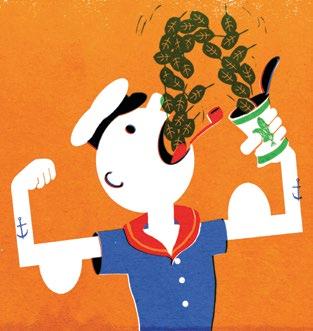
WHere did tHe mytH come from?
We all know that Popeye had spinach to thank for his muscles. Unfortunately, outside of cartoons, this vegetable isn’t quite as miraculous as we’ve been led to believe. The idea that spinach is full of iron dates back to 1870 and a research paper written by Dr Emil von Wolff, a German scientist. His figures showed that it had an astonishingly high amount present.
In fact, this was a mistake as he’d misplaced a decimal point in his calculations—so the result was ten times higher than it should have been. This faulty measurement was not noticed until the 1930s but, by then, the idea had stuck.
WHat’s tHe trutH?
Spinach might not be quite as full-to-bursting with iron, but it does contain more than many vegetables. Unfortunately, it’s not all good news. Iron comes in different forms—the non-haem form found in spinach is hard for the body to use, as it’s absorbed very slowly. Spinach also contains a chemical, oxalate, which binds with iron and makes it even harder for the body to absorb.
so, tHere’s notHing to Worry aBout?
There’s no doubt that spinach is good for you— it has lots of nutrients as well as fibre. But if you want to build muscles like Popeye, you can’t rely on spinach alone.
Illu S trated by d av I d Hump H r I e S | 09•2015 56 H ea Lt H
FOR MORE, GO TO readersdigest.co.uK/HeaLtH

























































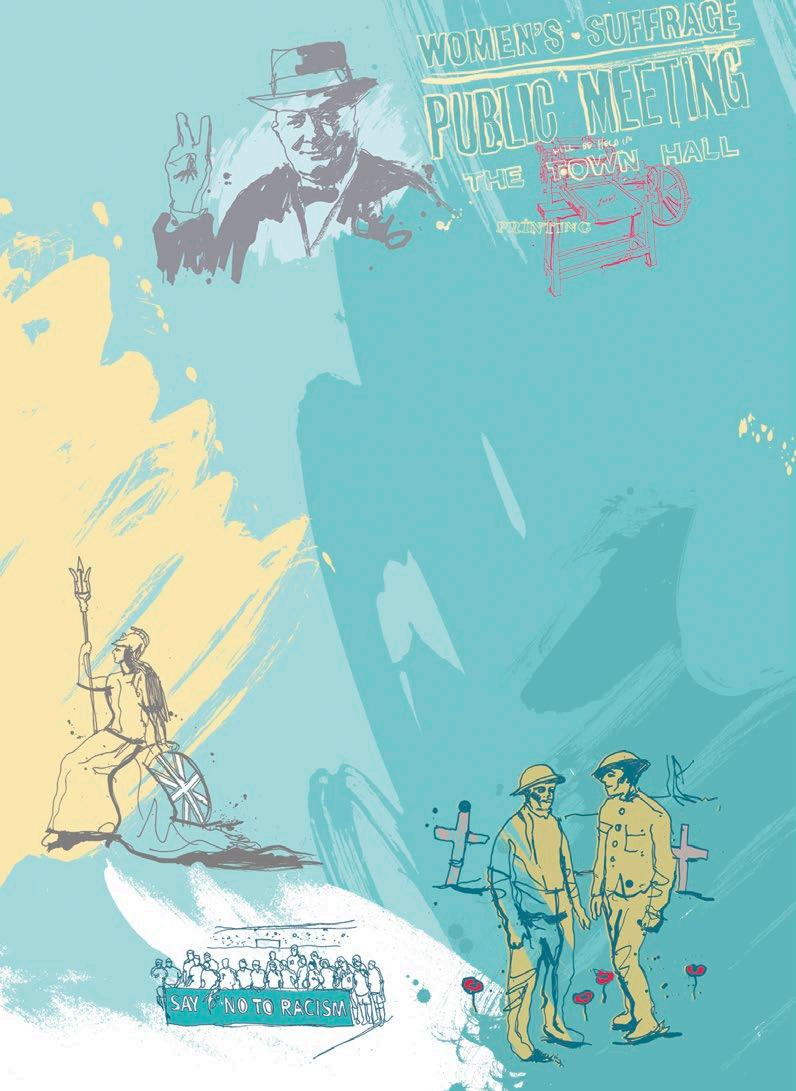
A Tale Of Two Queens
By Jo y P ERS aud
Both reigns have broken records, but how do the lives of Queen Victoria and Queen Elizabeth II compare? And which legacy will endure?
Illustrat I on by b en t allon INSPIRE
58

After 63 ye A rs, Queen e l iz A beth ii becomes the longest-reigning monarch in British history this month (September 10, to be exact), breaking the record set by Queen Victoria, her great-great-grandmother.
These renowned sovereigns have experienced vastly different times. Victoria—who ascended to the throne at 18—oversaw the industrial revolution, the extension of the right to vote, the British Empire and progressions in science and medicine that dramatically extended life expectancy.
Elizabeth, whose life was put on a somewhat unexpected trajectory after her uncle Edward VIII abdicated, is widely regarded as the modern royal family’s redeemer.
Now 89, she has reigned through post-war Britain, the formation of the Commonwealth, the Swinging Sixties, national and international conflicts, terrorism, the rise and fall of trades unions and the staggering rise of technology. Since being crowned in 1953, Elizabeth has maintained a dignity that seems to balance out the decline of religion and the lusty forthrightness of
present-day Britain, where hereditary rule isn’t quietly accepted and criticisms are shared worldwide by anyone who can swipe a screen.

Though the media was, naturally, not as ubiquitous—or, some might say, as pernicious—in the 1800s, Victoria’s views were kept private. The elite who surrounded her didn’t, for instance, disclose her dislike of Prime Minister William Gladstone or her disdain for democracy and votes for women— views that were only made public after her death in 1901. Her decade-long retreat from public life after Prince Albert died aged 42 didn’t do Victoria any favours, and triggered the formation of a republican movement while she mourned her husband. But she
60 A TALE OF TWO QUEENS © K E y S TONE Pic TU r ES USA/A LA my | 09•2015
Elizabeth and Philip after her coronation
did return to the public eye towards the end of her reign, and regained a popularity that endures to this day.
Victoria’s Golden Jubilee in 1887 and her Diamond Jubilee a decade later were celebrated with much verve, with Victoria writing in her journal on September 23, 1896, that she’d “reigned longer, by a day, than any English sovereign”. She noted the festivities that were held to mark the occasion—the souvenir plates, the rejoicing church bells and numerous telegrams. But while she appreciated the loyalty that sparked these gestures, she didn’t encourage them. Her great-greatgranddaughter will take the same stance, with the Palace preferring to focus instead on planning Elizabeth’s 90th birthday in April next year.
This is largely due to the respect held for her predecessors. Elizabeth doesn’t want the event to be seen as a celebration of Victoria’s death; her priority is that of public duty rather than bombast, and she aims to uphold a sense of respect around the milestone.
regArdless, Queen eliz Abeth has had to contend with living her life in an increasingly public fishbowl, where every move is scrutinised. Professor Robert Hazell, director at The Constitution Unit, University College London, comments, “Under Queen Elizabeth, the monarchy has become more open, with TV programmes filming the royal family at work and at play. There are risks here: the risk
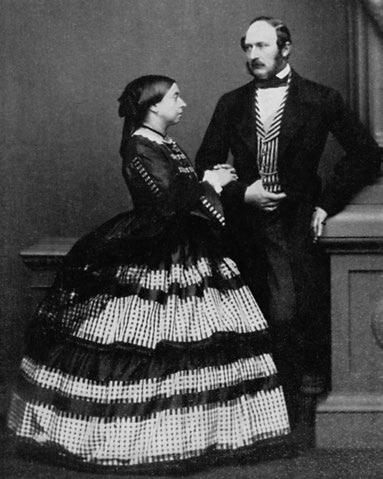
of becoming part of celebrity culture and the risk of William, Kate and their children losing their privacy.”
Dr Robert Morris, a former Home Office civil servant, believes that intensive media attention has done much to dispel any “mystique” of monarchy, adding that Elizabeth and members of her family suffer a degree of intrusion unimaginable in Victoria’s time.
He says, “There have been changes in the way in which the monarchy presents itself. Under Victoria, the monarch didn’t seek to establish the kind of public presence now the norm, or see it as desirable to seek public approval. The monarch was first and foremost at the apex of government and wasn’t
Reade R ’s d igest 61 © Th E Pr INT cOLLE c TO r/A LA my 09•2015 |
Queen Victoria and Albert in 1861
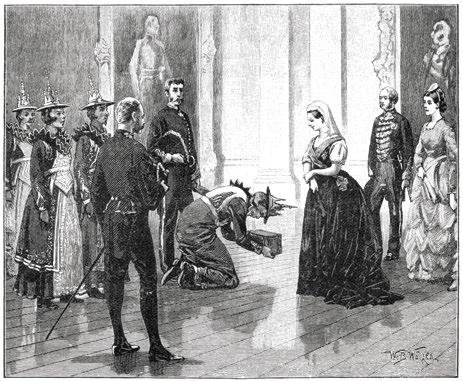
conspicuously associated with charitable endeavours.
“Elizabeth, on the other hand, inherited and has developed what has come to be called the ‘welfare monarchy’— that is, the deliberate cultivation of a public identification with, and the promotion of, ‘good works’ and publicspirited endeavour. Through acting as patron of a great range of charities, she expresses an active interest in their work, and the charities themselves benefit from the connection.”
Dr Morris says that while these activities are inherently useful, they also fill a role vacant in post-imperial times—and pre-empt criticism of just how useful the royals are.
One of the 600-plus patronages Elizabeth holds is that of the promarriage and family Christian charity Mothers’ Union—a position that was
first held by Queen Victoria in 1898. Like Elizabeth, Victoria was interested in what might be deemed charitable acts—even though she didn’t need to be seen to carry these out to satisfy her public. She favoured measures to
improve the lives of the poor, recognising over time that inadequate housing was damaging the mental and physical health of those who lived in filthy, tiny homes.
Dr Morris continues, “Apart from limited smoke-abatement legislation, there was little by the way of conscious environmental policy. It took the Great Stink of 1858—when hot weather exacerbated the smell of human waste and industrial effluent on the banks of the Thames—to lead to the first major pan-London sewage works.
“Public health improved under Victoria, but slowly. There were still cholera outbreaks in the late 1840s and tuberculosis remained a scourge throughout Victoria’s reign. One of the important achievements of the second half of the 20th century, and during Elizabeth’s reign, was the reduction of pollution and the elaboration of effective planning controls.”
The Royal Commission on the
62 A TALE OF TWO QUEENS © Th E Pr INT cOLLE c TO r/A LA my | 09•2015
“The Queen Receiving the Burmese Embassy”, by William Barnes Wollen
Housing of the Working Classes led to the construction of the first councilhousing estate, in London, starting in 1893. Victoria’s Britain also funded libraries, wash houses and public swimming baths for all to use. The mood of the time, often characterised by the wealthier doing their Christian duty to help those less fortunate, saw the formation of the Society for the Relief of Distress, the Peabody Trust, Barnardo’s and the Charity Organisation Society, all of which have had a lasting impact on society’s deprived.
A nd wh At of their politic A l positions? Vernon Bogdanor, professor of government at King’s College, London, and author of The Monarchy and the Constitution, says a significant difference is that of the control they wield—or, indeed, do not. He comments, “The main change is that Victoria had a fair amount of political power, which the present queen doesn’t want and doesn’t have anyway. One symbol of how the queen’s power has declined was after the 2010 election, which led to a hung parliament. Some people said that this would involve the queen’s discretion in choosing a prime
minister, but she remained at Windsor for five days while the coalition was being hammered out. No one could accuse her of being involved, and the Palace’s view was, ‘Let the politicians decide and we will endorse the outcome they reach.’ They aren’t decision makers, but facilitators. It’s not for the queen to take an active role, and that’s very different to Victoria.
“Queen Victoria personally chose, after Gladstone’s retirement, Lord Rosebery—without asking Gladstone’s view. It’s possible he wouldn’t have been the Liberal Party’s choice.”
Politically, the British Empire was of course a major part of Queen Victoria’s
The Queen attends a cabinet meeting at No 10 in 2012—for the first time since Queen Victoria’s reign—alongside David Cameron and William Hague
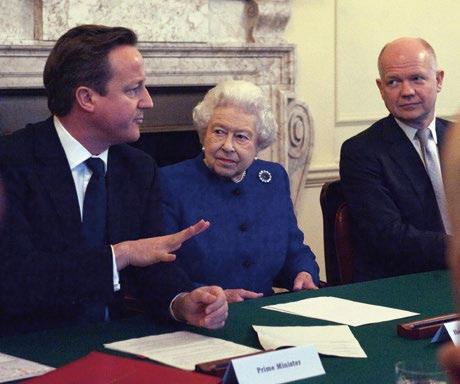
Reade R ’s d igest 63 © WENN UK/A LA my 09•2015 |

life. By 1922, more than 458 million people lived in the Empire, which represented more than one-fifth of the world’s population at that time. But two world wars ultimately led to its collapse. The Empire was transmuted into the Commonwealth as the former mostly became independent but retained a UK link. Elizabeth is head of state in 15 other Commonwealth countries.
Queen Elizabeth greets the crowds on a state visit to Germany in June this year
Dr Morris comments, “Elizabeth was personally very closely identified with that change, and the attention she’s given to Commonwealth affairs has been closer perhaps than her ministers sometimes wished.
“In hindsight, the decay and transformation of the former Empire is of less continuing importance than membership of the European Union from 1973. Joining entailed a cession of a degree of sovereignty, pooled also in membership of international bodies such as the UN, Nato and the Council of Europe with its European Convention on Human Rights, all of which come with an international court with jurisdiction over UK affairs. These changes show the distance travelled since Victorian times, which never saw the UK signing up to any continuing forms of significant international, collective governance.
64 A TALE OF TWO QUEENS © dp A pic TU r E ALL i AN c E /A LA my
| 09•2015
“Most European monarchies have disappeared as the result of the sort of climactic state failure, which hopefully the UK will avoid. The French revolution couldn’t make the experiment with limited monarchy work, and the Hapsburgs, Hohenzollerns and Romanovs went following catastrophic failure in war.”
the royal family’s approval ratings have been in the 70–75 per cent region, even during the 1990s, when they were splashed across newspaper front pages for all the wrong reasons. This is unquestionably down to Elizabeth—she’s been criticised for not being forthcoming in some situations, but her majesty in the face of uproar is where her strength lies. Professor Bogdanor echoes this. “We
don’t know what Elizabeth’s own views are. That’s part of her strength—she never gives interviews.
“It’s difficult to judge who’s been more impactful. Victoria and Elizabeth both represent the soul of the country —both had, and have, a fairly instinctive view of what the country wants and likes.
“Elizabeth has more of a human touch than Victoria, but you weren’t required to have it then. She has a gift for ceremonial dignity. They both gave a basis of stability in changing times. Length aside, Queen Elizabeth has shown very good judgement throughout her reign. She’s much loved.”
Our Queen and many other royal DVD titles can be found in the Reader’s Digest shop. Visit shop.readersdigest.co.uk
HAPPY HOMO SAPIENS
These little-known animal facts will make you glad you’re a human:
If a female ferret doesn’t mate while in heat, she’ll die.
Mice can sense sadness in other mice.
Sharks lose one tooth a week.
Garden lizards eat their own tails for calcium.
Pigs can’t see the sky due to the position of their eyes.
Domesticated rabbits only live for 24 hours in the wild.
SOURCE: SADANDUSELESS.COM
Reade R ’s d igest 65
09•2015 | |

BEst of BRitish
Attractions s ubterranean
By fiona hicks
From secret walking routes to not-so-smelly sewers (yes, really!), there’s plenty to see if you go underground
66
ins P i RE
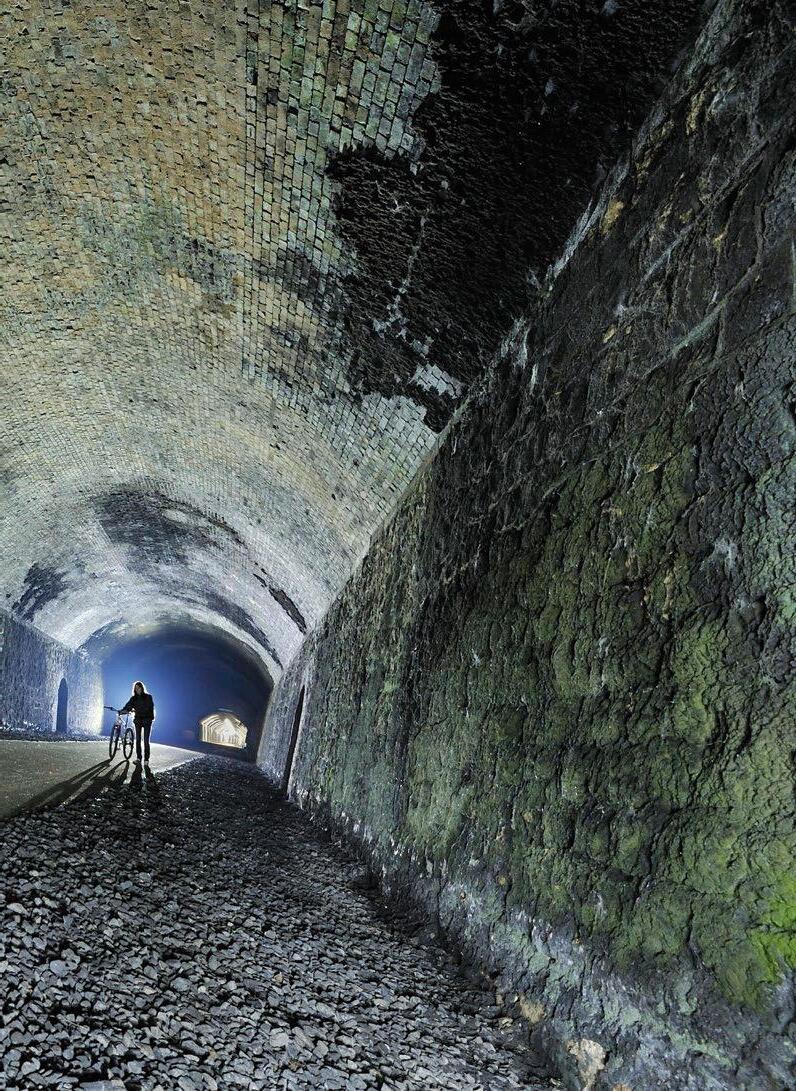
Monsal Trail
PEak DistRict
This diverse route spans eight and a half miles in the Peak District.
Suitable for walking, cycling and horseback, it follows the lines of the former Manchester, Buxton, Matlock and Midlands Junction railway. As you’d expect from a railroad, the route delves underground through several stretches of tunnels, the longest of which is more than 500 yards long.
Whether on two feet or two wheels (or indeed, four horsey legs), there’s something exhilarating about meandering through the atmospheric, traffic-free passages. Four of the seven are lit, but visitors are advised to take a torch during late afternoons and evenings. For those with time to linger, there are also boards explaining the unique history of the route.
■ Visit peakdistrict.gov.uk for details


Tar Tunnel
shRoPshiRE
Ironbridge is certain to inspire an interest in the Industrial Revolution, even for those who can’t tell a steam train from a tube line. The Tar Tunnel is one of the gems of this World Heritage Site. It was here that
best o F british | 09•2015 68 previous image: © r obbie s hone/a lamy / © stephen F leming /a lamy
➸
Bitumen has been oozing down these tunnel walls since the 18th century

miners struck gold—or bitumen, to be precise—while attempting to build a transport network through the gorge in the late 18th century.
“It’s certainly a curiosity,” says director of marketing Paul Gossage. “It’s not like potholing or anything that unpleasant—you just have to
stoop down a little bit, walk along the brick-lined tunnel, and you can still see the tar oozing down the sides.”
Visits take no more than 20 minutes, but time yours for late morning and you can pop to nearby Blists Hill Victorian Town for lunch.
■ Visit ironbridge.org.uk for details
R E a DER ’s Dig E st 09•2015 | 69 69
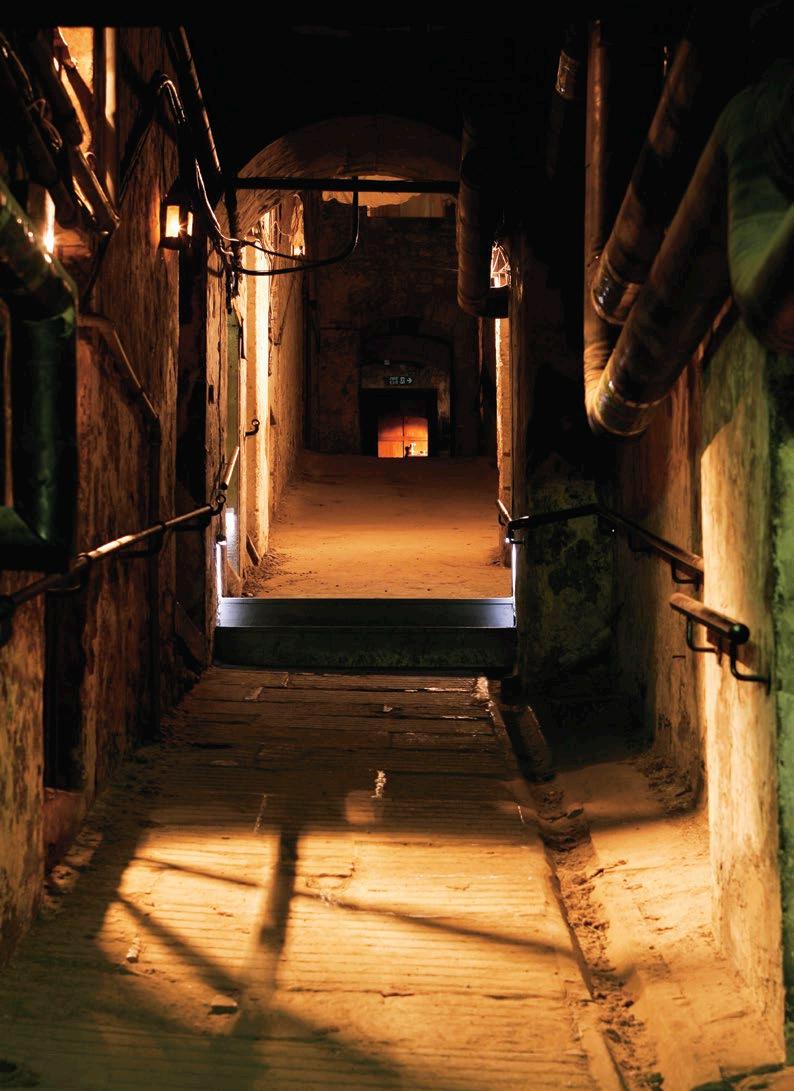
The Real Mary King’s Close is the site of many sinister and ghostly happenings
Real Mary King’s Close EDinBURgh
Hidden under Edinburgh’s Old Town is a warren of streets and subterranean spaces. Once open to the skies, Mary King’s Close (named after an eminent 17th-century businesswoman) was consigned to the darkness when the construction of the Royal Exchange began in 1753. The close may be covered, but it’s brimming with tales of murder, plagues and ghostly happenings.
“There’s nowhere else quite like
Brighton Sewers sUssEX
Yes, these are working sewers, but the majority of the attraction lies in the Victorian structures that are clean enough to walk through rather than wade—for fascinating and revealing tours.
Donning hard hats and protective latex gloves, visitors learn all about the construction of the 30-mile-long sewers. The mortar in the labyrinth of tunnels was made from sand from Brighton Beach, and if you look closely enough you can see shells encrusted in the walls. Today’s sewers are made from concrete, and it’s also illuminating to discover what happens
The Real Mary King’s Close” says general manager Craig Miller. “We offer an insight into Edinburgh’s history, telling stories of real people.”
In-costume attendants bring these 400-year-old narratives to life, along with the interactive gallery room. If you’re visiting with a group, it’s worth booking “The Dark Truth” tour, which runs late at night and provides a captivating experience of the more sinister side of Edinburgh’s past.
■ Visit realmarykingsclose.com for details
when we flush the wrong things down the loo.
There is of course a slight odour— but, says Southern Water, “It’s not overpowering. Many visitors say the smell isn’t as bad as they expected.”
■ Visit southernwater.co.uk/ brighton-sewer-tours for details

R E a DER ’s Dig E st 09•2015 | 71 © e d r obinson/ o ne r ed e ye
Hell Fire Caves
BUckinghaMshiRE
The mock-gothic entrance of these caves sets the tone for the bold, mysterious and strangely opulent space that follows. It’s the former haunt of the notorious Hell Fire Club, where Sir Francis Dashwood and his cohorts held lascivious, bi-monthly meetings in the mid18th century.
“It takes roughly half an hour to go all the way down to the bottom of the cave,” says Mary Hilder, the estate secretary for the Dashwood family (who still runs the caves today). “At the bottom there’s the River Styx, and you can also look into the inner temple down there. It’s both bizarre and fascinating.”
For those who prefer less-ghostly settings, there are above-ground tea rooms that serve home-made cakes.
■ Visit hellfirecaves.co.uk for details


Tunnels Beaches
DEVon
Underground passageways leading to the sea? It sounds unlikely, but that’s exactly what you’ll find in Ilfracombe. Tunnels Beaches is home to some of the country’s most wellpreserved bathing pools. Dating from the early 19th century, these are where men and women would immerse themselves in order to relax and convalesce.
The surrounding caves were used by smugglers until the 1820s, when hundreds of Welsh miners toiled for two years to create 175 yards of
best of british | 09•2015 72 © r obert s tain F orth/ a lamy


tunnels, allowing for much easier access to the cove. Information boards line the way, which means that after educating yourself on Victorian etiquette, you can reward yourself with a dip in the tidal pool.
Says local Dotty Sibbald, “Lots of people buy season tickets to swim.”
■ Visit tunnelsbeaches.co.uk for details
Williamson’s Tunnels LiVERPooL
These were commissioned by the wealthy and purportedly eccentric businessman Joseph Williamson in 1810. The purpose of the tunnels is widely disputed. Some say Williamson feared the end of the word was nigh, so was building a refuge. He himself claimed it was an act of philanthropy, in which workers “all received a weekly wage and were thus enable to enjoy the blessing of charity without the attendant curse of stifled self-respect.”
The extensive excavation work is “all done by hand, so we only use spades, buckets and wheel-barrows”, explains volunteer coordinator Sian Roberts. As well as tours, there are regular events.
■ Visit williamsontunnels.co.uk for details
have you delved underground? Email us at readersletters@readersdigest.co.uk

09•2015 | 73 R E a DER ’s Dig E st
Send us your holiday snaps—it could win you £400 or a luxury holiday in Turkey!
Family Holiday Competition
Photo

Pal’s son from above.
“I don’t think you need a smiling face to show a happy holiday”
sponsored by
you can still enter our photo competition if you’re quick!
Simply take a compelling picture that sums up your experience of family holidays. We’re looking for unusual approaches, so don’t restrict yourself to the obvious portraits. Families and holidays are broad categories, so use your imagination!
It will be judged by the Reader’s Digest editorial team with the help of professional photographer James Eckersley, and the winning entries will be published in our October issue. Turn the page for entry details and a description of the second holiday for two: the Hidden Treasures tour. See previous issue for details of the Magnificent Turkey tour.
INSPIRE
Pal’s wife and son. “A camera on holiday is there to make you remember moments you live with your family”
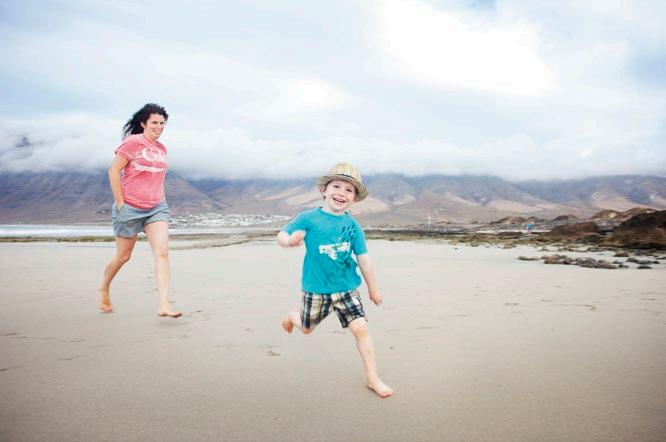
Photographer Pal Hansen explains how he captures a single moment.
I recently spent two weeks with family in Lanzarote, Gran Canaria. Normally on holiday, I bring a small, compact camera that I can easily take around with me, which I’m not nervous about damaging when bringing to the beach. I also bring a SLR camera that I can use for the shots I want to pay a little more attention to, or that I feel need a “fast camera” (compact cameras can often have a delay when photographing, which makes it harder to capture action sequences).

Whether photographing my family on holiday or going on a job, I always try to find interesting angles. I don’t think you necessarily need a smiling face to show a happy holiday. A shot of a two-year-old boy in a paddling pool—naked except for a hat—taken from above tells just as much about my son as a shot of his smiling face above the water. His character comes out in the fact that he has a hat on in the pool, and his size is revealed by the shadow he casts.
With both cameras, I set them to manual mode so I can have full control of depth of field, shutter speed and flash.
I think the most important thing as a photographer is to remember that a camera on holiday is there to make you remember moments you live with your family—not to live the moments of your family through the camera.
09•2015 | 75 Pho T o S © Pal h an S en / www. P alhan S en.com
Details of Tour 2: Hidden Treasures
DAY 1: ARRIVAL
Arrive at Antalya and get whisked away to your luxury hotel, where you’ll meet your tour manager.
DAY 2: MYRA & BOAT TRIP

Coach journey to Myra, famous for St Nicolas, followed by an amazing glass-bottomed boat tour of Simena (Kekova), the sunken city. End the day with a short coastal journey to Fethiye and check in at the hotel.
DAY 3: DALYAN CRUISE
Dalyan River cruise where nature is at its best—if you’re lucky, you’ll spot the Carreta Carreta turtles. Then stay at Kusadasi, known as “Bird Island”— an ancient site full of art and culture.
DAY 4: EPHESUS
Visit Ephesus, Basilica of St John. Finish the day with a wine tasting in
how to enter
J Take a high-resolution photo with either a phone or digital camera. After saving it as a jpeg no larger than 2MB, go to readersdigest.co.uk/ photo-comp and use the form to upload. Entries must be in no later than 5pm, September 1, 2015.
Sirince, an authentic Turkish village, then return to the hotel in Kusadasi.
DAY 5: PAMUKKALE
Visit Hieropolis and the hot springs of Pamukkale, one of the world’s most beautiful natural wonders. Retire to your spa hotel in Pammukale.
DAY 6: TAURUS MOUNTAINS
Visit a handcraft exhibition and view
J There are two categories—one for adults and one for under-18s. The under18s prize is £400, while the adults winner can choose between a pair of holidays for two supplied by our sponsor: Hidden Treasures (above) or Magnificent Turkey (see previous issue).
J Please mark your entry “Adult” or “Under 18” when submitting.
| 09•2015 76 FAMILY HOLIDAY PHOTO COMPE TI TION

rug- and kilim-making, an ancient Anatolian tradition. Take in the beautiful Taurus Mountains on a coach journey back to Antalya.
DAY 7: ANTALYA
Take in the “Turkish Riviera”. Start with the city centre, with the famous Three Gates, the Old Town castle and historic harbour, then enjoy the breathtaking Karpuz Kaldiran waterfall.
DAY 8: DEPARTURE
Rules: Please ensure that all pictures are original, taken specifically for this competition and not previously published. Please include your full name, age, postal address, email address and daytime phone number with all correspondence. If you’re under 16 you must ask your parent or guardian’s permission to enter this competition. We may use entries in all print and electronic media. We cannot acknowledge or return your entry.
n Seven nights’ accommodation in selected fivestar hotels.
n Return flights and transfers.
n Daily buffet breakfasts and evening meals at the hotel.
n Daily lunches at different authentic Turkish restaurants.
n welcome cocktail upon arrival.
n modern airconditioned coaches.
n Dedicated, friendly, englishspeaking guide.
n entrance fees to all sites and museums visited.
n no hidden fees!
Contributions become world copyright of Vivat Direct Ltd (t/a Reader’s Digest).
Entry is open only to residents of the UK, Channel Islands, Isle of Man and Republic of Ireland. It is not open to employees of Vivat Direct Ltd (t/a Reader’s Digest), its subsidiary companies and all other persons associated with this competition, their immediate families, and relatives living in an employee’s household. The judges’ decision is final. n
Reade R ’s d igest 09•2015 | 77
thE holIday © Panom/S h UTT e RST oc K
From campaigns to courses to community, the Women’s Institute has been quietly enhancing lives for a century
“I’ve Never
Made Jam!”
By JO y PERSAUD
If you picture women in aprons making myriad pots of jam when you think of the Women’s Institute, it’s likely that you haven’t encountered this dynamic organisation recently.
While members of the WI did indeed make jam to provide food during the war effort, they are a formidable force of people who run campaigns addressing issues such as domestic violence, female genital mutilation and food wastage—as well as maintaining the values of community and education upon which the organisation was originally founded.
One hundred years on from when it was first established in the UK in 1915, the WI has

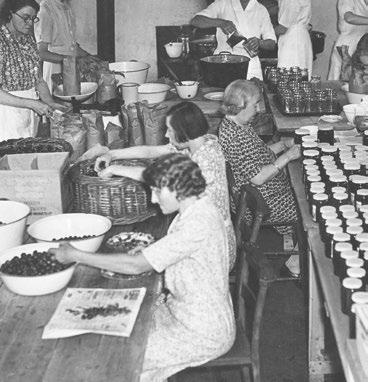
| 09•2015
78
INSPIRE
The WI campaigns in 1954; (top) members preserve food to contribute to the war effort; (right) the first WI meeting venue in 1915


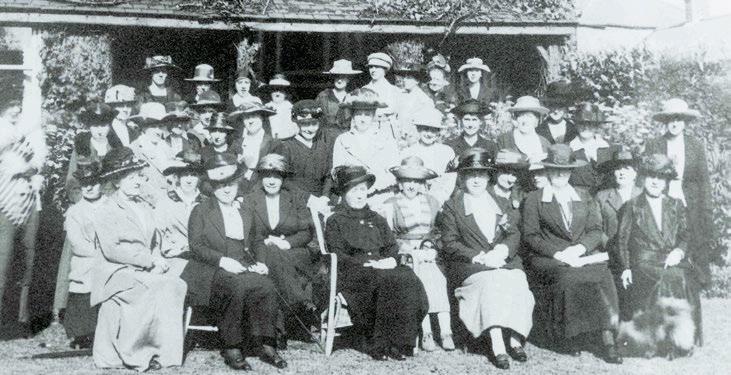
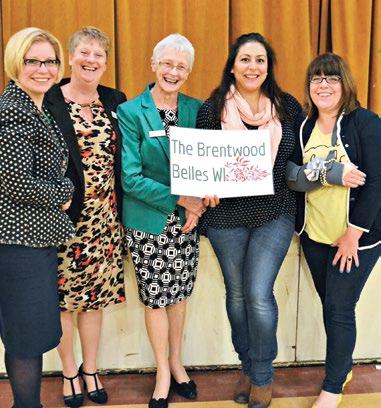
managed to retain its wholesome image while moving with the times. Currently, the National Federation of Women’s Institutes (NFWI) is sending out 1,000 packs a week to new members. So what is it about the WI that has helped it to not only endure, but to thrive? Four women lift the lid on this versatile organisation.
Jane Miles, branch president, Brentwood
Jane Miles, 41, joined The Brentwood Belles WI in 2010 because, she says, “It’s a force to be reckoned with and I thought it would be fun to take part —it’s an organisation that makes it
achievable for women to lobby and campaign about their rights and those of women worldwide.
“In terms of campaigns, we’re very member-led,” continues Jane. “So each year the committee reviews what we’ve done to date, what the current [national] resolution is and any other causes brought to our attention. We look at our membership and how they would like us to approach the issue in a way that they can get involved.”
Jane, who’s in her third term as branch president, has helped with numerous projects, including knitting woollen breasts so a local hospital can demonstrate the correct position for breastfeeding, embroidering a “genitalia quilt” to support the fight against female genital mutilation, providing at least one Christmas present for children of women at a local refuge and donating to a local food bank.
“Our main way of campaigning may be relatively low key, but it’s about raising awareness at a more local and more relevant level,” she says. “We all hear about national campaigns, but it’s about relating it to our members so they can see the impact on them as an individual—and how they can make a difference to those around them.”
Jane describes her neighbourhood as a highly commuter-populated area, and says the WI gives people a sense of community that could otherwise slip away. The branch sends a card and flowers if someone is unwell, or to celebrate a success or birth, and
80 “I’VE NEVER MADE JAM!” | 09•2015
Jane Miles (second left) with The Brentwood Belles, demonstrating the age diversity in the WI
members will “provide hugs when times are really tough”.
Giving local support is a priority for The Brentwood Belles WI. When one of their members, Sue, lost her husband Pete to cancer, 14 Belles and family members climbed over the O2 to raise money for the hospital ward in which he’d stayed.
Jane recalls, “I was dreading it, and my knees were knocking as we had our briefing and made our way to the starting point. The majority of us were afraid of heights, plus I had to have some physio to be ready for it due to ongoing knee and back problems. But we were determined to do the climb for Sue, in memory of Pete.
“The start and end of the climb are up some really steep steps. And then you traverse a walkway suspended above the O2, which is made of what seems like trampoline material. It’s so bouncy it really adds to the feeling that you’re doing something dangerous. I was at the front of our group and the lady behind me was quite anxious, so she then decided to
bounce along to distract herself, which made me even more nervous. I nicknamed her Tigger. There was a lot of chatty banter between us all to keep our nerves at bay.
“Due to the way the River Thames weaves, you can see Canary Wharf and Wembley in the same view. Sue was on the climb, so the feeling on reaching the top was partly exhilaration and partly incredibly moving. The serenity on Sue’s face at achieving that in Pete’s memory brought a lump to my throat.”
The climbers raised more than £3,000 and are now working with Southend Hospital to buy various items to make the end-of-life experience more comfortable and less stressful for patients.
“There will also be a rocking chair in Pete’s name,” says Jane.

The Belles (plus one husband) climbed the O2 for charity
Reade R ’s d igest 81 09•2015 |
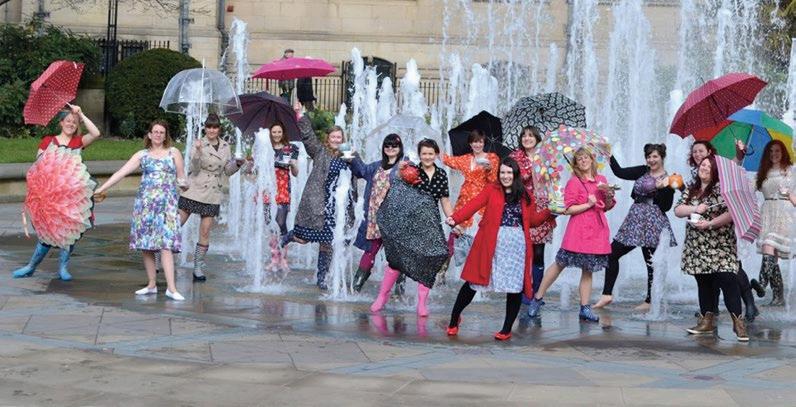
Kirsty Bowen, president, s even Hills
Although she’s been involved in many campaigns, Jane primarily joined the WI to make friends, a benefit that draws many members. Similarly, Kirsty Bowen wished to expand her social network after completing her studies in Sheffield, as many of her friends had moved away.
Now president of Seven Hills WI, Sheffield, the 28-year-old recalls, “I wanted to make friends outside of work and I’d seen Seven Hills WI in the local press, as they’d just opened and been extremely popular with younger women.
“The WI can bring many things to a community—a ready-made circle of friends, a sense of belonging and purpose outside of the workplace for
women. I’ve made such close friends who I talk to every day, and who have given me so much fun and support.”
Kirsty acknowledges that her family and old friends first thought it was “a bit weird” that she was joining the WI at 23; now, she says, they are impressed with her involvement. Like many of her peers, Kirsty admits that her biggest surprise was finding out about the WI’s campaigning history, including “Keep Britain Tidy”, which started as a NFWI resolution in 1957 and is still running as a charity.
“The WI wasn’t something I was very aware of before I joined—I just knew the stereotype of older ladies knitting and eating jam,” she says. “I didn’t realise the organisation had this amazing campaigning past—lobbying for women’s rights, health concerns
82 | 09•2015
“I’VE NEVER MADE JAM!”
The WI calendar shoot in Sheffield’s Peace Gardens fountains (Kirsty is in yellow)
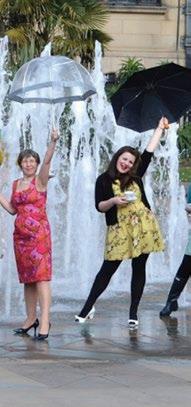
and environmental issues that had actually changed British society for the better. I want our group to pay tribute to the WI of the past and continue this great tradition of helping our communities.”
Marylyn Haines-Evans, vice chairman, Llangadog
Marylyn Haines-Evans, 58, is the vice chairman of the Llangadog branch. She belongs to the third of four generations of women in her family who are WI members. Her memories of the institute extend to her early childhood, when she would happily take the hands of her mother—a member of 75 years’ standing, who’s now 91—and her grandmother to attend regular meetings in the South Wales community hall.
She smiles, “I’ve never made jam, so it’s quite amusing really that people think that’s all we do. In 2011, we [supported] ‘no more violence against women’, as it was proposed that there was going to be a £350m cut in legal aid at that time, and that would
have had a detrimental effect for anybody trying to leave a violent partnership. I remember it was in the middle of summer and I was on a soapbox outside the Royal Courts of Justice on a loud hailer. Radio Five Live [was there] and I did an interview as well. There were several members there with placards and it was well worthwhile because we did [secure] some concessions from the proposals. [Domestic violence victims] do qualify for legal aid now whereas they wouldn’t have. That was a real victory.
“We do a lot on excess packaging as well, and clear labelling. I’ve gone down supermarket aisles and actually asked supermarket managers why there’s excess packaging. You just have to keep at it to get changes made. I do tell them I’m from the WI and they respond very well to that.”
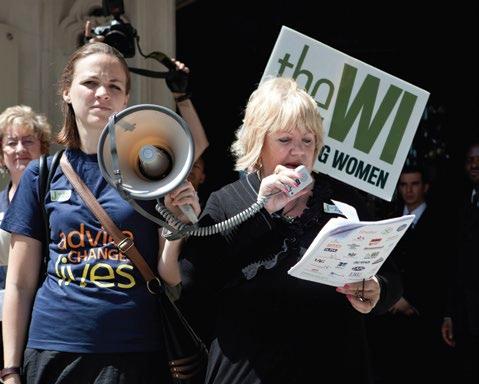
R EADER ’ S D I g ES t 83 09•2015 |
© Lou I s E H A y W oo Ds c HIEF
Marylyn (right) at a Legal Aid rally in 2011
Joy Morgan, member of wi, Bookham
Joy Morgan joined the WI in 1964 when she was a new face in her neighbourhood, having moved to Bookham in Surrey. While waiting for her young son outside the nursery door, she began talking to another mother, which led to an invitation to join the WI.
She recalls, “My membership of the WI helped us all to settle down in our new home in the village. For two years, my husband’s career took us to the Royal Military College of Science in Shrivenham, where fortunately there was a WI, which offered much more than the group of Military Wives.
Joining from an academic background, I was surprised to discover how much the WI can offer in terms of challenging adult education.”
The intellectual stimulus provided by the WI has been important to Joy, who went on to serve as branch president and other committee roles over the years. Through the organisation, she earned an accredited certificate for teaching adults, which led to a part-time job.
As Joy points out, education is at the heart of the reason the WI was founded in 1897, after a Canadian woman Adelaide Hoodless lost her 14-month-old son due to a lack of
A BRIEf HIStORy Of tHE WI
1897 The first Women’s Institute is formed in ontario, canada.
1915 The WI is introduced to Britain, encouraging women to get involved in growing and preserving food during the First World War.
1921 WI member Margaret Winteringham is elected as MP for Louth. she’s the second-ever woman to be elected to parliament.
1940 The Ministry of Food allocates sugar to the NWFI. This dramatically reduces food wastage by allowing produce to be preserved.
1954 WI member The Queen Mother attends the annual general meeting. A resolution is passed to start a national anti-litter campaign—Keep Britain Tidy is born.
1979 “The Great Jam Debate” takes place. The NWFI successfully lobbies to exempt WI members from having to register their kitchens with local authorities in order to sell jam.
1990 The WI celebrates its 75th anniversary with an AGM addressed by the Her Majesty the Queen.
2012 3,083 members come together in the Royal Albert Hall, breaking the Guinness World record for the most people knitting simultaneously in a single location.
84 “I’ VE NEVER MADE JAM !”
| 09•2015

knowledge surrouding health issues. This loss drove Adelaide to educate rural women in domestic science and agriculture, as well as giving them a chance to socialise. In 1948, the UK’s WI founded Denman College in Oxfordshire. This large Georgian mansion is where members and nonmembers can still take a plethora of courses today.
The best part of belonging to the WI, says Joy, has been the enduring friendships that have supported her in good and bad times. Her daughter Caroline observes, “It’s been a great way for mum, and by extension the rest of the family, to be involved with the community in the various places she’s lived and through phases of life.”
And what of the future? Marylyn thinks the key to the WI’s longevity is its willingness to move with the times.
She explains, “If we’re going to survive, especially for the next 100 years, we’re going to have to do a lot of what we’re already doing and simply keep ourselves relevant. Our members are just fantastic. Nobody gets paid at the WI and that’s a huge part of the success— people are doing things because they really want to.”
For more information and details about key campaigns, visit thewi.org.uk
ONE-LINE WISDOM
It’s no mistake that “stressed” is “desserts” spelt backwards.
SOURCE: PINTEREST.COM
09•2015 | 85
R EADER ’ S D I g ES t
Joy (centre front): “I was surprised to find how much the WI can offer”
Aged 87, Daphne Selfe is the world’s oldest supermodel.
Since appearing in Vogue aged 70, Daphne has worked all over the globe, including campaigns for Dolce and Gabbana, Nivea and Olay
If I Ruled the World Daphne Selfe
More ads would feature the elderly. People become invisible as they grow older, and advertising, with its focus on youth, has a lot to answer for. As long as you’ve kept yourself fit, wouldn’t people like to see more of our society represented in the media?
I’d reduce packaging. Why is everything wrapped in plastic and cardboard? It’s such a terrible waste of resources and an environmental scandal. And I can’t open any of it without breaking my nails! Last time I tried to unwrap a new toothbrush, I had to take a knife to the packaging.
People would pick up the phone. I’ve had to keep up with technology because that’s the way of things now, but I want to speak to people too. I love chatting with my friends on the phone. I’m sure if more people used their phones actually to call each other and took the time to talk, it would help with the sense of isolation many people feel as they grow older.



INSPIRE | 09•2015 86
illu S tr A te D by J A me S Smith
We’d all eat healthily and get out in the fresh air more. I was brought up during the war, so we learned to value and respect food. We never threw anything away. I eat fish, chicken and vegetables, and drink lots of water. I love going for walks and gardening. I’m sure it’s one of the main reasons I’m still so fit and active. Parents should take their children out into the country and show them how our food is bred and grown. I was buying fresh peas in their pods the other day, and a woman asked me what they were!
I’d tell women not to change their natural beauty. I’ve never had any cosmetic surgery—it seems like a terrible waste of money. Who wants a young face on an old body? Spend your money on something that makes you feel better in body and mind. I love going to the theatre and cinema with my friends—it’s an invigorating way to spend time.
I’d ban background music during TV programmes. I find it hard to hear the dialogue, especially during nature programmes. I watched the wonderful docudrama The Story of the Weeping Camel recently and it was such a delight, with no music to distract or annoy the viewer.
No one would eat in public. Then the amount of fast-food litter would be a thing of the past. And, on trains, it’s horrible sitting next to someone
eating—it’s so smelly and messy. People should try to be more considerate of those around them.
I’d like all programmes to be printed black on white. When I go to the theatre, where the lighting is bad at the best of times and my eyesight isn’t what it was, I can’t read the programme if it’s printed on a colour background.
Women would be equal to men. We’ve come a long way in my lifetime, but in some countries women still don’t have a voice. Everyone should be able to have their say. It comes down to education of both men and women—I’d like to see women take their place alongside men throughout the entire world.
Everyone would be curious and stay positive. I know someone who’s never left Baldock, the town where I live in Hertfordshire. The world is a fabulous place and should be seen! And staying positive is one of the keys to a happy life. I know it’s not always easy, but the attitude people had in the war was a good one. We were taught to get on with things, however hard life was, and pulled together. Life’s too short to sit around feeling sorry for yourself.
As told to Caroline Hutton
Daphne’s memoir The Way We Wore is published by Macmillan and out now.
09•2015 | 87
FOR MORE, GO TO READERSDIGEST.CO.UK/INSPIRE
Property Trust Wills What are they?

A WILL IS AN IMPORTANT LEGAL DOCUMENT, possibly the most important many of us will ever sign, but your Will might not be everything you imagined. A standard ‘Mirror’ or ‘Joint’ Will may appear to keep things nice and simple, but they also fail to protect what you’ve spent a lifetime building. These basic Wills often create a situation where the survivor of a couple is left owning everything, and has everything to lose in their later years if they need to move into a care home, for example.
HOW DOES A PROPERTY TRUST WILL WORK?
A Property Trust Will is often suitable for co-owners of a property (often husband and wife, or unmarried couples), and is used to ring-fence half the family home on the first death of a couple. A Property Trust Will protects the half the home for
the next generation from the threats of care fees and the effect of remarriage, both of which frequently see an inheritance pass somewhere it wasn’t intended to go. When setting up a Property Trust Will, the legal title to the property is changed from joint tenants to what is known as tenants in common – nothing to do with renting, but an important change at the Land Registry that allows each co-owner to decide where their half share of the property passes on their death.
This type of Will gives the surviving co-owner the use of the half of the house in trust for the entirety of their lifetime, ensuring they can continue to live in the property as if they owned it, and they could even move house if they wished. Because the half a house is in trust, it can’t be used to fund care fees, and can’t pass sideways to a new husband or wife – it is protected for the next generation.
ADVERTISEMENT FEATURE
COULD IT BE RIGHT FOR ME?
There is no ‘one size fits all’ solution to your legal planning. It is essential that the right solution is created for your personal situation, and specialist advice is essential. A starting point is the review of your existing planning, circumstances and objectives. As a reader of Reader’s Digest, you have exclusive access to
the services of Reader’s Digest Legal, and can arrange for a professional Estate Planning Practitioner to visit your home without charge or obligation. A free one hour consultation in the comfort and privacy of your own home will allow you to learn what steps you could take to upgrade your planning.

Take the first step and find out more about Reader’s Digest Legal and Property Trust Wills by requesting your free information pack today. Call 0800 031 9516 and quote reference RDL5.

Along The Wine Route
In hilly, magical Alentejo, Portugal, I renew a friendship, and discover the best eating and drinking of my life
By Eli Gottli EB
Photos B y jam E s
E
rajott
trav E l & adv E ntur E

91
Opposite: the town of Montemor-o-Novo; (this page) wines of the Alentejo
the surprising thing about touching down at Lisbon airport is how fast, heading south in a car, you find yourself transported into deep countryside. I arrived on a mild October morning, was met there by my old friend Martin Earl, and within a few minutes was crossing the Vasco da Gama bridge—longest in Europe— that stretches across more than ten miles of the Tagus River estuary. Immediately thereafter we swerved off the road and decelerated into the dreaming, older world of the Alentejo (the word literally means “beyond the Tejo” or Tagus).
For the next five days, we’d travel among mediaeval whitewashed villages, rolling hills, mountain forts and a constellation of sparklingly modern vineyards. Long a holiday destination for budget travellers, the Alentejo is rapidly becoming one of the world’s top wine destinations.
I was there to sample the landscapes and hospitality with my friend, who would also be my guide. Martin and I were part of a group of five guys, now middle-aged, who’d all met at university, been star-struck by the dream of literature and had remained adream ever since. But differently from the rest of us, Martin, a poet, had “gone native”, settling down with a local girl in Portugal and crossing over into a life lived entirely in another language. I was eager to understand a little bit more what three decades of voluntary exile does to a person.
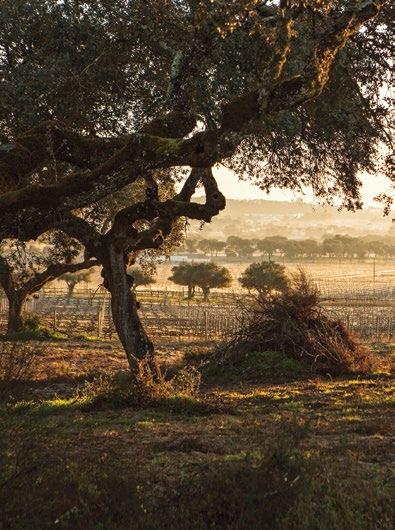
By now, 40 minutes from the airport, we were passing through sun-dappled alleys of plane trees with, beyond them, irregular row upon row of cork oaks. “I sometimes call this area Corktugal,” Martin said with a laugh. The beautiful cork oak is hand-harvested of its bark once every ten years. The forests themselves are a giant cash cow—60 per cent of the global cork trade originates in Portugal.
We stopped for a coffee in a sleepy, sun-blasted village called Montemoro-Novo. There seemed to be a single cafe. But was it a cafe? The sign above it read: “ Grupo de Pesca Desportiva à Linha de Montemor-o-Novo. ” This was a local hand-line fishing club, Martin explained, devoted to the old, pure form of the sport in which the
T | 09•2015 92 A long the w I ne route

designated an Intangible Cultural Heritage of Humanity by Unesco. Better yet, one of the singers was right there and about to be feted.
We watched as a waiter presented the singer—distinguishable from the other patrons only by his dyed blond hair—with a tray bearing a white cube, roughly the size of a small brick.
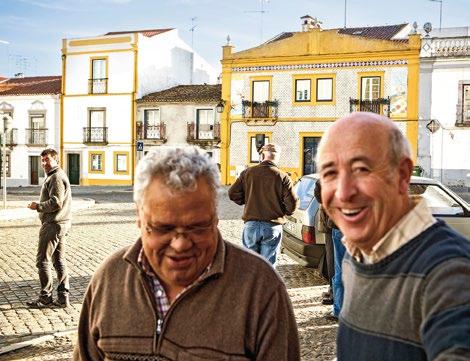
line is held in the hands, dropped to the bottom and jiggled in emulation of live bait. The cheerful, potbellied locals seated outside immediately waved us in.
An excited barista explained that they were about to celebrate something extraordinary. The traditional Cante Alentejano , a polyphonic singing unique to the region, had just been
“Lard,” Martin said simply. In Rome I’d often seen ribbons of the stuff consumed like a kind of bacon sushi, but this was a block of pure porky fat and I watched, amazed, as the singer tucked a napkin into his collar and began forking pieces into his mouth with a great smacking of the lips.
We drank some of the deliciously bitter coffee and continued on our way. The route lay south-east, in the direction of Spain, and we took secondary roads, the better to savour our surroundings. With the windows
rE ad E r’s d i GE st
09•2015 | 93
Above: cork oaks, which resemble stouter, leafier olive trees. Portugal is responsible for 60 per cent of the global cork trade; (right) cheery patrons of a local hand-line fishing club in Montemor-o-Novo
open, the Fiat buzzed like a blender. Roadside eucalyptus trees sent a delicious tang through the air.
Martin and I caught up while the tilled brown fields rose and fell outside the windows. Often we were stuck behind contraptions that resembled riding lawnmowers fitted with rudimentary car bodies. These slow, sputtering vehicles are known as “mata-velhos”—“old person killers”— because their tiny 20-cubic-inch engines don’t require a driver’s licence to operate and because they are often driven—and crashed—by the elderly.
We turned off for lunch in a smallish town called Redondo and found a promising-looking place, Porfírio’s , with whitewashed walls and beamed ceilings. A tray of tasty appetisers, or entradas , was soon placed on our table: herbed and vinegared olives, breads, sausages and two kinds of fresh cheese. The lunch itself opened with an exquisite dogfish soup—the dogfish is a kind of shark, whitefleshed and sweet—followed by arroz de pato, or duck rice.
Portuguese cooking works through a process of concentration of essential tastes bolstered by fresh ingredients. Arroz de pato is a classic example of this magnification-through-reduction. The lid of baked egg atop the rice was dotted with broiled bits of incredibly savory bacon and chouriço, a sausage similar to chorizo, both of them sourced from local pigs. Plunging your
fork through the lid released a jet of flavourful steam, and below the rice a vein of moist, darkly delicious duck.
But a last word about that pig. The animal reigns at the top of the food chain on Alentejo menus, consumed in nearly all its parts. The local specialty is porco preto, or black pig, fed mostly on the acorns that fall from cork trees and presented in sausage, bacon and chops and as an enriching agent in a variety of stews. The animal’s intense depth of flavour is due partly to that acorn-heavy diet and, as a bonus, those acorns imbue the flesh with oleic acid, the same heartfriendly ingredient found in olive oil.
The next two days would take on an easy, natural rhythm of eating, sightseeing and drinking the cheap, wellstructured local wines. We stayed in the mountain towns Monsaraz and Marvão. Each was originally built as a fortified redoubt against invasion from nearby Spain and was visible from the valleys below, looking like a kind of terracotta headpiece. Each was entered through several miles of switchbacks and inside the thicklyfortified walls had an array of steep cobbled streets, a castle, a small museum, shops, restaurants and panoramic views.
But it was in these showcase mountain towns, alas, that I felt the weight of the tourist trade wearing away some of the indigenous sparkle. The restaurants tended towards the tired, and the little ateliers and stores that
| 09•2015 94 along the wine route
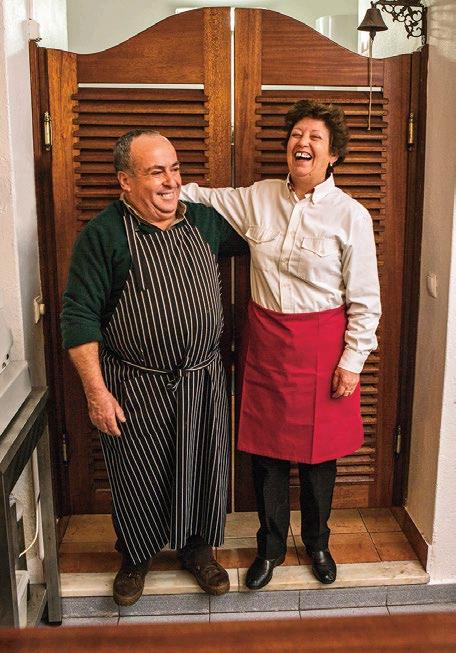
honeycombed the alleyways seemed filled mainly with kitsch.
After two days we returned to the plains and began following signs for rota dos vinhos, or wine route. These soon brought us to the Adega Mayor winery, a hypermodern collection of cubes and cantilevers set out in the hills and designed by the famous Portuguese architect Álvaro Siza. We toured the ingeniously constructed building and sampled some of the exquisite wines.
But it would be at lunch the next day
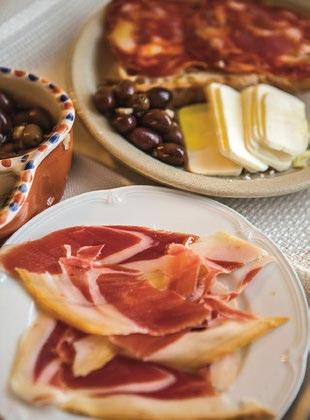
that Portugal would finally offer up a truly world-class dining and drinking experience. It would take place at the Herdade dos Grous , a giant vineyard and estate in a village south of Beja, a town boasting a hotel and a restaurant whose services we sampled.
In the high-ceilinged dining room, with views over the vineyards and a man-made lake, we ordered the chef’s tasting menu accompanied by paired wines. The meal opened with a luxe version of typical entradas, the flavour of each small meat, cheese and
rE ad E r’s d i GE st
09•2015 | 95
Mariana Perdigão, owner of Porfírio’s, and her husband Eliseu in Redondo; (above) a classic appetiser of sliced ham, cheese, olives and chouriço

vegetable dish as particularised as the panes of a stained-glass window. A lighter-than-air dogfish soup was followed by a veal medallion set in two Nike swooshes of mustard sauce, served with fingerling potatoes, a topping of radish sprouts and divinelyroasted chickpeas.
The paired wines of Herdade dos Grous began with a clean, delicate palate-cleansing white, accompanying the meal along an arc of increasing depth and complexity that ended with the cymbal crash of a 2011 Grous Reserva red. The net effect of this was one of the great culinary transports of my life.
Afterwards, I talked with Luís Duarte, 48, the man responsible for the extraordinary wines I’d just drunk and the only one of Portugal’s vignerons to have been named winemaker of the year twice. “I belong to the first class that studied winemak-
ing in school, professionally,” he said. “Instead of working in the Douro [Portugal’s traditional wine region, farther north] I decided to head south to the unsung Alentejo. It was my good luck to get in on the ground floor of the worldwide growth of wine and ride that exciting wave.”
When asked the difference between Portuguese wine and that of other nations, Duarte didn’t hesitate. “The wines of Chile and Argentina are too sweet,” he said. “You think Spain, you think the tempranillo grape. Well, we don’t use the same grapes everyone else does. We have 315 different grape varieties, many of them unique to us.” With a wave of the hand, he indicated the glasses on our table. “You want a velvety and well-balanced wine at a good price? Think Portugal.”
After lunch, we strolled in the nearby vineyards. It was late afternoon, the sun low in the sky. The air was filled with nostalgic aromas of earth and mown grass, and I found myself remembering my own nearexile in Italy, where I’d spent a total of eight years. Different from the Alentejo, Italy is long accustomed to being a sightseeing shrine of sorts, and its tourist treasures often have a kind of annealed feeling to them, as of having been visited so often that they’ve been buffed smooth by the experience.
But Portugal, and particularly the
| 09•2015 96
The Alentejo’s local specialty is porco preto, or black pig, which mostly feeds on the acorns that fall from the cork trees
Alentejo, give an entirely different impression: that of a place—showcase mountain towns apart—still waking up to its own worldly importance and, as a result, still vivid and fresh.
We were almost returned to the main building when we saw a golden retriever amble out to greet us. The dog was approached by a farm cat. Instead of fighting, the two touched noses. “Around here,” Martin said, “everyone’s so happy that even interspecies enemies kiss and make up.” We laughed and turned back towards the car.
Back in the airport in Lisbon, I hugged my old friend goodbye. I was relieved to have found him at peace in his adopted country. There’s an essential melancholy in exile—a sadness from the severed connections to family, habit and what the poet Paul Celan called the “fatal once-only” of the mother tongue—that can weigh on those who’ve made the move.
In Martin’s case, these deficits were offset by a good marriage, his devotion to his art and a country whose ancient ways allowed him the kind of concentration that frenetic New York would have almost certainly denied.
In the process, coincidentally, that country had offered me two things: a reassuring insight into the adaptability of human nature over time, and a tour of the hilly, magical Alentejo, with some of the very best eating and drinking of my life.
travEl tiPs
Lodging B and B hotel, rua do raimundo, 99, Évora, near the main square, offers good value, parking (35-1-266-240-340; hotelmoov.com).
Casa Pinto, Álbares Pereira, 10, monsaraz, offers charming rooms and a hearty breakfast; (35-1-266-557-076; casapinto.es).
Food Café Alentejo, rua do raimundo, 5, Évora, has regional fare at reasonable prices (35-1-266-706296). the Herdade dos Grous restaurant, Albernôa 7800-601, Beja, offers top-flight contemporary Portuguese cuisine, and lodging is available in the nearby hotel (35-1-284-9600-00; herdade-dos-grous.com).
Touring organised wine tours: Wine Routes of the Alentejo, Praça Joaquim António de Aguiar, 20, Évora (35-1266-746-498; vinhosdoalentejo.pt).
an im P ro B a B l E PE rson
Scientists estimate that the probability of your being born is 1 in 400 trillion.
SOURCE: TED.COM
The New York Times (JA nuA ry 18, 2015) co P yr I ght © 2015 by t he n ew york tI me S co. www.nyt I me S .com
Reade R ’s d igest 09•2015 | 97
Nice Guy In Wine e
Portugese proof of how Naked Wines Angels are changing the wine-making world
Negreiros is a teeny-tiny producer of handcrafted Portuguese wines. The man behind the operation, Mario Negreiros, is one of a kind—you won’t meet a humbler, nicer guy on the planet. We’ve been itching to tell his story for years, but his output was too small to shout about. Until now.
Some years ago, Mario was living abroad in Brazil. But in 2004, he met the love of his live (from Brussels) and a wine conference, and that was it. He knew they had to be together…and that meant moving back to Portugal.
When he told his father Joaquin of his intention of returning to Portugal,
his father encouraged Mario to take over management of the family winery Quinta das Amendoeiras, bought by his grandfather some 70 years previously. For generations, most of the Touriga grapes from the family vineyard in the Douro Valley had been sold to make expensive port. But Mario had a different plan—he wanted to use their best grapes to make their own wine. And so, in 2004, Mário kept some of his plumpest, juiciest fruit back, and start making his own red wine—Negreiros wine was born.
A few years later, a group of Naked Wine Angels were on a trip to Portugal when they chanced upon Mário and his wine. “We have to have more of this heavenly juice!” they cried. They were instantly hooked.
Mário’s tiny winery was only set up to make a few hundred bottles at a go. So Naked Wines Angels stepped in,
ADVERTISEMENT FEATURE
WINE

offering funding that changed Mário’s life. With newly kitted out tanks, oak barrels and temperature controlling installed, the quality of Mário’s wines went through the roof.
Angel funding also gave him the clout to snaffle even more spectacular fruit, and to age his wine for longer. The result is a brand new, wonderful wine with 2 years in cask called Nu— which means ‘nude’ in Portuguese.
If you want to understand the impact of this huge, full-bodied red, imagine the freshest, most succulent black cherry you’ve ever scoffed, with just a rumour of pepper and dark chocolate on the finish. Then double it.
Mario is a charming character with superb wine that’s exceptional value-for-money. We have more than a few of these winemaker stories to go around.
We have lots more stories (and delicious wines) just like Mario’s... If you’d like to find out a bit more about Naked Wines visit nakedwines.com/readersdigest. Take the quiz and get a £30 voucher to spend on mouth-watering wine!
There’s “so much to explore” in the Canadian city
By Catherine Cole
My Great Escape: Vancouver Adventure

Christina Westwood from Shrewsbury recommends the Canadian city as a fun family destination

Catherine has danced in Rio, been microlighting in South Africa and hiked the mountains of Oman
Tell us about your favourite holiday (send a photo too) and if we include it on this page we’ll pay you £50. Go to readersdigest. co.uk/contact-us

Seal S bobbing in the water; hiking trails against the backdrop of modern skyscrapers; stunning art, incredible sunsets and hundreds of restaurants serving every type of cuisine imaginable—this is why my family and I enjoyed Vancouver.
We started in the downtown area, where there’s so much to explore. There’s the British Columbia Halls of Fame with its memorial to Terry Fox (a young, local man who achieved his goal of raising millions of dollars for Cancer Research), the Vancouver Art Gallery, the bustling shops of Robson Street, and the glorious beaches that stretch for miles. On our first night, we watched an outdoor cinema screening at English Bay. With a picnic, an enthusiastic crowd and the beautiful sunsets behind us, it was the perfect ending to our first day in the city.
We spent several more days exploring the many distinct neighbourhoods on foot: the historic Gastown area, which is a former mill town; Chinatown, with its huge offering of food and souvenirs; the waterfront area including Canada Place, where we admired the harbour views.
| 09•2015 100 travel & adventure
© All C A n A d A Photo S /Al A my
According to our three children, the highlight of our trip was cycling along the sea wall in Stanley Park and spending the afternoon by the Capilano River. Not only did we test the incredible suspension bridge over the gorge (apparently strong enough to hold the weight of a full Boeing 747) but the treetops adventure boardwalk led us straight through the lush West Coast rainforest, providing views that will always be etched in our memory. The end of a week’s memorable holiday arrived too soon. There was still so much to do in Vancouver, such as kayaking with orcas, whitewater rafting on the Fraser River and exploring the Gulf Islands in the Strait of Georgia, but all this will have to wait for our next visit. We look forward to returning!
■ a vanCouver vaCation Return flights to Vancouver start from £644pp with Air Canada (0871 220 1111; aircanada.com).


this year marks the official American 50th anniversary of the Vietnam War, and it’s also the year that the beautiful Southeast Asian country opens up for business. With visa requirements recently abolished for UK citizens, it’s now easier than ever to visit Vietnam. The long, slender country has vast miles of beach to enjoy—such as the lush Halong Bay outside of Hanoi—but its cities are also interesting melting pots of culture. Ho Chi Minh City (formerly Saigon) is buzzy and full of life, with plenty of beautiful French colonial architecture to gawp at. Just watch out for all the motorbikes…
■ voyaGe to vietnaM Wendy Wu offers a 12-day “Vietnam at a Glance” trip from £2,190pp. Price includes all travel, accommodation, meals and daily tours (0844 288 5396; wendywutours.co.uk).
09•2015 | 101
Things To Do This Month

Singapore in two minute S
■ See: Marina bay
Celebrating its 50th birthday, the Asian city-state is in celebration mode this year. The vibrant Marina Bay area is a good place to start—check out the futuristic Gardens by the Bay, where the trees light up to music each evening (marina-bay.sg).
■ Stay: raffleS
Singapore’s most famous hotel boasts an impressive history and guestbook. Indulge in the colonial glamour and refined atmosphere before ordering a Singapore Sling at the hotel’s Long Bar. Rooms from around £687 a night (+65 6337 1886; raffles.com)
■ e at: Street food M arket S
Singapore has a glowing reputation for food. Check out food markets in Chinatown, Little India or the huge hawker centre of Lau Pa Sat (visitsingapore.com).
Short/long haul:
foodie trip S
Short: Just a short hop across the Channel is Guernsey, which has beautiful beaches and a lively food scene. The island’s first international food festival takes place at the end of this month, so expect local island food in a series of special dinners and cook-offs. September 18–27 (visitguernsey.com).

long: Capital Taipei’s street-food stalls are some of the best in the world. Masterchef Travel offers a ten-day trip to Taiwan from £2,345pp, including flights, accommodation, meals and transfers (020 7873 5005; mastercheftravel.co.uk).

travel app of the Month
trails, £3.99 for one year, ioS Whether you’re climbing, cycling or simply walking, this GPS app records pretty much anything that involves movement (trails.io).

| 09•2015 102 tr A vel & A dventure
FOR MORE, GO TO readerSdiGeSt.Co.uK/travel-adventure © GA rden S B y the BA y

✔ 20” trolley case, 20” travel bag and 19” flight bag fall within most airlines’ hand luggage measurements
✔ Super tough rugged construction
✔ Comfy shoulder straps on bags
✔ Sturdy wheels makes cases easy to move
✔ Front zip pocket on all cases and holdalls
✔ Easy storage - all fit inside each other

Great Value, Wherever
You 5-Piece Luggage Set for ONLY £99.99* READER OFFER Get All This Quality Luggage for Less than £100!
Your Travels Take
ORDER NOW! Call 0844 332 8080 shop. readersdigest.co.uk (Quote RDP031 when ordering)
essentials Product code: P10465 * plus £9.95 p&p SAVE £100 RRP £199.99
Whether you’re jetting off long haul or planning a weekend getaway, this great value set makes room for all your
Fed up with poor returns from your savings?
DO YOU REMEMBER A TIME WHEN YOU COULD ENJOY A GOOD RETURN ON YOUR CASH SAVINGS?
If low interest rates have left you fed up with poor returns from your cash savings you might be interested to know that you can have two ISAs every year. Reader’s Digest is introducing you to Scottish Friendly to offer you somewhere different to invest your money.
SOMETHING DIFFERENT FROM JUST £10 A MONTH
Cash savings can of course provide instant access, interest and the security of knowing you will always get back at least what you have paid in. But don’t forget that inflation could reduce the value of the money you get back so it could be worth less than you have paid in, particularly given current low interest rates.
An Investment ISA gives your
money access to a wider range of investments than a secure cash account alone.
Scottish Friendly’s Investment ISA gives you the chance to make your money work harder than a cash account by giving it access to the long-term growth potential of the stock market. From just £10 a month it’s affordable too.
YOU CAN HAVE TWO ISAS EVERY YEAR
You can put money aside tax-free in an Investment ISA as well as a Cash ISA. In the current tax year you can invest up to £15,240 in an Investment ISA (also known as a Stocks and Shares ISA), less any amount already saved in a Cash ISA.
Remember the value of your investment can go down as well as up and you could get back less than you have paid in. If you cash in before
ADVERTISEMENT FEATURE


the end of 5 years there will be a £50 deduction from your cash-in value. Tax-free means the policy grows free of income or capital gains tax (other than tax on dividends from UK shares). Please note that tax treatment depends on your individual circumstances and tax law may change in the future.
WHY PEOPLE CHOOSE SCOTTISH FRIENDLY
Scottish Friendly has been helping people to save and invest for over 150 years and are one of the largest mutuals in the UK. As a mutual they


work solely for their customers rather than shareholders.
WANT TO KNOW MORE?
To find out more about an Investment ISA from Scottish Friendly visit: www.readersdigest.co.uk/isa
If you choose to take out an Investment ISA, Scottish Friendly will send you a £25 My Rewards card when you start investing to spend at over 70 UK retailers such as Amazon, M&S, Next and John Lewis.
Scottish
register
Scottish Friendly Asset Managers Limited. Registered O ce:
Friendly House, 16 Blythswood Square, Glasgow, G2 4HJ. Authorised and regulated by the Financial Conduct Authority. Details can be found on the FS
– Registration No.188832. Member of e Investment Association.
image of fed-up couple .indd 1
MONEY
Four Myths About Credit Ratings
Whether you’re taking out a loan or simply want to check, the reality of your credit report is often better than you think
B Y N ick hill

Nick Hill is a money expert at the Money Advice Service. Visit money adviceservice. org.uk for details

A credit report gives lenders an idea of whether you’re likely to repay a loan or not. If they don’t like what they see, they won’t lend you the money or may not give you the best rate. However, credit ratings and reports can be easily misunderstood. Here are the most common credit-rating myths—and the truth behind them.
A bad credit rating is for life
This is the one that tends to worry people the most. But it doesn’t have to—as it’s completely false. Missing or late payments will stay on your credit file for six years. It’s a long enough amount of time that you should try to avoid it as much as you can, but if you do find yourself in a difficult situation, it doesn’t mean you’re stuck with it forever.
Credit ratings only affect mortgages, loans and credit cards
If you’ve got a poor rating, you might find you’re rejected when you try to switch energy provider, bank account and even your mobile-phone contract. Each time you apply for credit, it’ll show up as a record on your credit report—which can be a bad sign to lenders. To avoid this, try not to open too many lines of credit at the same time. If you’re getting a new credit card, for example, avoid setting up a mobile-phone account simultaneously.
| 09•2015 106 MONEY

You could find yourself on a universal credit blacklist
There’s no such thing as a universal credit blacklist. Different lenders look for different things when they’re deciding whether or not to lend to you. One tip is to stop applying for credit as soon as you find yourself in difficulty, as that can create a spiral. Getting on the electoral register can also help.
Checking your own credit report damages your rating
This is another one which pops up a lot, but it’s not true. You can check your credit report as much as you like without affecting your rating. In fact, it’s worth having a quick check if you think you might be applying for credit soon, or if you’ve got any new credit to see how it’s affected your credit report. You have the legal right to see a copy of your report for £2. There are three main credit-reference agencies you need to check: Experian, Equifax and Callcredit (via the Noddle website).
Some offer a free trials for a month—and Noddle is entirely free—but you’ll have to provide your credit- or debit-card details. You can read more about how to check your credit score at moneyadviceservice.org.uk.
09•2015 | 107 Illustrat I on by D an MI t CHE ll
Get Better At Planning Ahead
Do you ever get caught without enough money to cover an emergency repair bill? Or do you struggle to cover the cost of Christmas and holidays?
For a lot of people, this happens because they don’t believe they have enough to save. But unexpected bills can really hit hard if there isn’t a savings buffer.
If you borrow to cover those costs, it can be easy to slide into a debt spiral. If you want to avoid getting in that situation, the best thing you can do is make a budget.
You can do this with a pen and paper, or there are tools to help you do the maths, such as the
Money Advice Service online budget planner. This will help you work out everything you spend and all the money you have coming in. From there, see if there are purchases you can cut back on, or cut out completely. You’ll be surprised how easy it is to find a few quid here and there.

■ reject cold calls. an unexpected phone call from someone you don’t know—about opportunities you haven’t expressed any interest in previously— could be risky. the safest thing to do is just hang up.
■ check the firm is regulated by the Financial Conduct authority (FCa). you can do this on their website.
■ don’t be rushed into making a decision. It’s important to check the facts before you make any irreversible decisions. remember, you could lose a lifetime’s savings in just a few moments.
| 09•2015 108 M on E y
TOp Tips TO avOid scaMMErs afTEr YOur pENsiON cash
© s H utt E rsto C k/ F u F unt E g
Are You Wasting Your Holiday Money?
Have you come back from your holidays with any leftover currency, or did you spend it at the airport?
New Money Advice Service research uncovers just how much currency we waste when on holiday.
Spending for the sake of it
Our research uncovered that, as a nation, we waste close to £1bn a year at airports just getting rid of leftover currency.
On average, we spend £14.27 per holiday at Duty Free or on food and drink before we fly—rather than bring it back home. It’s also estimated that we need £52 worth of cash before we think it’s worth coverting it back.
What to do with your leftover currency
It’s easier than you think to make use of foreign money. If you’re likely to go back to the same country soon, you could put it towards a fund for your next trip.
If not, even though you’ll lose a
little on the exchange rate, switching it back means you’ve some extra cash for Christmas, birthdays or holidays.
Still to go away?
If your holiday is still to happen, make sure you exchange your money for the best possible rate before going on your trip.
The difference between shopping around for the best rates in advance and getting money at the airport can be as much as 10%.

rE ad E r’s d ig E s T © EggH E a D P H oto/ a la M y
FOR MORE, GO TO rEadErsdigEsT.cO.uk/MONEY 09•2015 | 109
Non-Standard Insurance:
Secure your home with confidence
HOUSES IN THE UK COME IN ALL DIFFERENT SHAPES AND SIZES. From a standard detached or semi-detached property, to flats, bungalows and thatched cottages, there is a huge variety on offer.
While obtaining insurance for standard properties is relatively straightforward, things can be more complicated for properties of a nonstandard construction and a specialist nonstandard home insurance policy will normally be required.
Properties which have shown signs of subsidence — when the ground beneath a building sinks, impacting on the property’s foundations — will not be able to obtain cover from a standard home insurance policy. e same is true of properties with a history of
flooding. Due to the extreme weather conditions experienced by parts of the UK in the last few years, an increasing number of properties have been affected by flooding.
Obtaining insurance for non-standard properties is not straightforward and a specialist policy will usually be required.
Non-standard property insurance covers a wide range of factors, including unoccupied property. Most standard home insurance policies only permit a property to be unoccupied for a maximum of 30 consecutive days. Unoccupied property insurance is often purchased when a property is being renovated or refurbished or following the death of a loved one, where a property may become vacant for many months, until the sale of the property has been completed.
atched properties will need to obtain specialist thatch property
ADVERTISEMENT FEATURE

insurance in order to ensure they have the correct levels of protection in place.
Landlord’s building insurance is compulsory, whereas landlord’s contents insurance is optional, but a sensible investment if the property is furnished. Policies are available to cover property portfolios, with the facility to add and remove properties accordingly.
Non-standard insurance also includes cover for people with an adverse claims or criminal history, cases where special terms or conditions have been imposed by an insurer, or where cover has previously been declined.
Whether you live in a house, flat, bungalow, thatched cottage or listed building, Reader’s Digest Insurance Services is delighted to offer a wide range of home insurance policies with excellent levels of protection. To discuss your property insurance requirements — and to obtain a competitive quotation — call us today on 0208 069 3102. One of our expert advisers will help provide the home insurance policy that matches your property’s exact requirements.
Vivat Finance Limited trading as Reader’s Digest are an Introducer Appointed Representative of Higos Insurance Services Ltd trading as Reader’s Digest Insurance Services, who are authorised and regulated by the Financial Conduct Authority FRN no 302690
Easy-to-prepare meals and accompanying drinks
Onglet Beef With Chimichurri
By Rachel walke R

Rachel is a food writer and blogs at thefoodieat.org
Serves 4
• 1–1.5kg onglet
• 1tbsp olive oil
• 2 sprigs rosemary
This dish con Tains T wo exci T ing elemen T s. Firstly, onglet—a lesser-known and cost-efficient cut of beef. Rich and flavoursome, it’s often referred to as “butcher’s steak” because it’s so delicious that butchers snaffle it for themselves. Onglet can be tough if not cooked properly though. Tenderise the cut first and always cook it rare, or medium-rare at most.
The second ingredient is a delicious Argentinean salsa called chimichurri, which is herby and fresh and tangy. Most people in South America have a strong opinion on what should go in a traditional chimichurri, but this is a solid recipe and goes brilliantly with the onglet.
• 30g fresh flat-leaf parsley leaves, finely chopped
• 5g fresh oregano leaves, finely chopped
• 3 garlic cloves, crushed
• ¼ red onion, finely diced
• 1 red chilli, finely sliced
• 30ml red wine vinegar
• 120ml olive oil
• pinch of salt
• pepper
1. Two hours before cooking, use a meat hammer or rolling pin to bash the onglet to tenderise it.
2. Rub the olive oil over the onglet. Bruise the rosemary and brush the meat with the sprigs, then leave
food & d Rink | 09•2015 112
Photogra P hY b Y t im & Zoë h ill

the oiled onglet and herbs in a dish, covered, at room temperature.
3. Pick the leaves from the parsley and oregano, and chop them finely. Mix the herbs with the crushed garlic, red onion, chilli and red wine vinegar.
4. Stir continually as you drizzle in the olive oil to finish the sauce. Use the salt to season to taste.
5. Preheat the oven to 200C and heat a skillet or griddle pan on the hob. Season the onglet with salt and pepper.
6. Press the meat against the pan, charring each side for 1–2 minutes. Transfer the skillet or griddle pan to the oven for 2–4 minutes (depending on the rareness you can handle, and size/shape of the onglet.) Let the meat rest for 5 minutes.
7. Slice the onglet thinly. Top it with the chimichurri. Serve with sweet-potato wedges, chips or green beans.
TRY THIS…
Chimichurri is best made a day in advance, and will keep in the fridge for a week. An empty Doritos Salsa Dip jar (300g) is a good size for storing this Chimichurri recipe. Shake before serving.
09•2015 | | 113
Argentinean Malbec

e verybody Talks abou T wine in Argentina all the time,” laughs Aurelio Montes Jnr, who left his family’s Chilean vineyards to start his own company in Mendoza—a renowned wine-growing region in neighbouring Argentina.
The history of Chilean and Argentinean wine production couldn’t be more different. Steady Chilean companies have long dominated the South American market. Meanwhile, Argentina produces five times the amount of wine—but until recently, exported hardly any.
“The arrival of big beer brands is what shook up the market,” explains Montes. Suddenly Pilsner provided another option, and the next generation of wine-drinkers was no longer guaranteed. Winemakers were forced to up their game.

Malbec is the country's signature grape variety. The Wine Society’s Exhibition is a classic Malbec, Kaiken Malbec is a big bold blend, and Aldi’s Exquisite Collection provides a great value option—all make a delicious accompaniment to a full-flavoured onglet and chimichurri.
■ The Society’s Exhibition Malbec, Mendoza, Argentina, £9.95/bottle


(The wine Society)
■ Exquisite Collection
Argentinean Malbec, £5.99/bottle (aldi)
■ Kaiken Malbec
Bonarda Petit Verdot
Limited Selection
2009 Mendoza, £9.99/bottle (Majestic)
| 09•2015 114 Food & d rink
© F E d E rico g arcia
Pudding of the Month

Dulce de Leche
Serves 4
An accidental over-order of milk saw in my first experiments with dulce de leche—the South American caramel. I poured the unwanted litres into a stock pot, added caster sugar and stirred it continually on a low heat until it turned into a light brown, sticky-sweet sauce. A traditional Argentinean use is to spread it between two cornflour biscuits to make alfajores. It's often used for a bannoffee pie—or added to brownie mixture—but I can’t think of a better use than dolloping dulce de leche over vanilla ice cream for an Argentinean sundae!
■ Merchant Gourmet Dulce de Leche, £3.49/450g (ocado)
■ Che Dulce de Leche Classic Style, £4/450g (casa argentina)
■ Bonne Maman Confiture de Caramel, £2.50/380g (waitrose)

This Is Your Cookbook, £25, www.thisisyour cookbook.com. Create a personalised book using family recipes.
BaRGaIN

good Food Talks, Free. This app makes restaurant menus accessible to those with visual impairments.
Blow-oUT

chef stand + wand for iPad/Tablet, b elikin, £29.99. A modern, tablet-friendly twist on a cookbook stand.
Reade R ’s d igest 09•2015 | | 115 © m agdal E na Paluchowska/ a lam Y Book FOR MORE, GO TO ReaDeRSDIGeST.co.Uk/FooD-DRINk
By Lynda C L ark

Lynda Clark is a homes, property and interiors expert, and is editor of First Time Buyer magazine
Autumn Statement
IT'S THE TImE of yE ar when we turn our thoughts to the new trends of the upcoming season. Colour is the key, and pastels—which are traditionally a springtime look—have been revamped for an inviting update. Take a fresh look at the use of sorbet colours, which will warm up any room when the colder days arrive. Combine these vibrant colours with geometric prints and retro shapes to perfect a modern space, or pair with delicate florals to create a classic country vibe.
Lausanne floral print armchair, £349; Hardwick chest, £249; Devon Stone tripod floor lamp, £69; rug, £120; plain Chenille cushion, £7; bird cage cushion, £14; recycled glass hurricane, £10; milky pink tealight holder, £2.25.
■ all available from Tesco (tesco.com)
Get The Look
Add a little vintage flair to interiors with these retro-inspired items.
■ 1950s oval wood coffee table, £59.95, Dotcomgiftshop, dotcomgiftshop.com
■ Geometric print vase, £30, House of Fraser, houseoffraser.co.uk
■ Leather bucket chair, £299, BHS, bhs.co.uk



home & Garden
| 09•2015 116


The BirdS and The BeeS
Encouraging beneficial bugs and beasties will not only help your garden to thrive—you’ll be doing your bit for the local ecosystem too. Filled with lots of snug little nooks and crannies made from bamboo and pine, this award-winning des res offers a cosy home for a variety of garden-friendly insects.
■ £26.99, Lakeland, lakeland.co.uk

WhaT’S hoT!
Eye-catching pieces make for pretty rooms


Pink wall clock, £25, Marks

annie mugs, £8.50 each, Berry Red, berryred.co.uk
09•2015 | 117
Laura oakes boudoir mirror, £50, Debenhams, debenhams.co.uk
& Spencer, marksandspencer.com
FOR MORE, GO TO readerSdiGeST.Co.Uk/home-Garden
Ordering Made Even More Easy
By olly m A nn

Olly is a technology expert, LBC presenter and Answer Me This! podcaster
AmAzon Echo, $179
A friend smuggled me this product in a suitcase, as it has no UK release date at present. It’s a 360-degree speaker, with no screen and few buttons, controlled via speech-recognition, answering to the name “Alexa”. So, for example, you can ask it, “Alexa, who is Olly Mann?” and it’ll search online to answer your query. Or—in case you wondered why Amazon invented it— you can ask Alexa to order you some toilet roll. Or chocolate, or toothbrushes...all charged to your account and delivered without you lifting a finger. An appealing concept.

ApplE App of thE month: DElivEroo, frEE
Bored of getting a takeaway from, er, your local takeaway? If you live in one of the 18 British cities where Deliveroo is active, you can order fresh food with a few


taps of your phone from upmarket eateries like Cabana, Leon and Ping Pong—and track your driver, Uber-style, as they approach your gaff with the grub. Good news for foodies, but bad news for your local chippie.
| 09•2015 118 Technology
immErsE vr GlAssEs, £29.95 from rED5
These plasticky goggles, reminiscent of the View-Master stereoscopes of my childhood, work with your smartphone to create a virtual reality effect: simply download a VR game from your app store, slide your phone into the glasses and, hey presto, you’re in Lawnmower Man. That’s the idea, anyway, and while it’s true your phone’s gyroscope will react to the tilting, shaking motions of your head as keenly as any high-budget display, I’m sorry to report the headset itself is uncomfortable. It’s designed for kids, I suppose, but it hurt my nose!

crAnkmonkEy, £99
This enables you to charge your gadgets—even in remote locations where electricity is scarce—just by cranking your hand. Jolly useful for adventurers who are running low on battery and need to check with basecamp or summon the emergency services. But serious wrist-power is required: it takes 20 minutes of cranking to generate enough juice for a ten-minute call.


AnDroiD App of thE month: moovit, frEE
So you’ve got your train app, bus app, Underground app and your GPS: what else could you possibly require? How about one that does it all? Moovit crossreferences data from timetables, plus live bus and train availability, and overlays it all on a pedestrian map to plot you a truly step-by-step route from point A to point B, and it works in over 500 cities.

09•2015 | 119
FOR MORE, GO TO rEADErsDiGEst.co.Uk/tEchnoloGy
By Geor G ina yates

Georgina is a fashion and beauty editor for numerous travel titles and a blogger at withgeorgia.com
Heading For The Top
IndIan-born, London-based desIgner Shilpa Chavan is no stranger to fashion week, having presented both in London and internationally.
Originally starting out in Mumbai, the artist, stylist and milliner relocated to London to launch her label Little Shilpa. “I love the transformative element that comes with millinery,” she says of her craft. “There are no rules and no boundaries. It’s creatively fulfilling— and technically fun as well—to challenge myself and balance so many things on a single headband!”
In 2009, she was one of five selected by prestigious milliner Stephen Jones for a showcase celebrating 25 years of London Fashion Week. “The feedback was
Aqua Vitae
Aquamarine is the go-to shade for prolonging the spirit of summer.
■ Monsoon’s “Lazio” dress shows off the trend (£129; monsoon.com).
■ Keep shoulders warm with White Stuff’s “Marianas” cardie (£39.95; whitestuff.com).
■ Boden’s pretty pumps finish off the look—and legs—perfectly (£79; boden.co.uk).



| 09•2015 120
Fashion & B eauty

amazing and, in fact, one of my headpieces also made it to the front page of The Guardian the next day,” says Shilpa of the experience.
The same year she created an entire outfit for the pop star Lady Gaga, whose weird and wonderful public image is the perfect fit for Shilpa’s out-of-this-world creations. Since these defining moments, her label has grown significantly and has recently come to include apparel design as well.
When planning her next range, Shilpa starts as soon as the last show finishes. “Each collection is always inspired from something around me at that moment,” she says. “I always design the headpieces first.”
Though in initial stages, Shilpa can divulge that her spring/summer range will explore fables, fairy tales and urban myths—the perfect way to add a touch of hedonism to your outfit.
■ Visit littleshilpa.com for details
one to watch: Minnan hui
Minnan Hui is a ready-to-wear designer who, since graduating from Central Saint Martins last year, has been quick to set up her eponymous label. Minnan presented her first catwalk collection at London Fashion Week in February, and will return to the runway this month.
But even before her catwalk debut, one of Minnan’s gorgeous silk frocks had already been worn by the iconic—and impeccably dressed—Grayson Perry. “It was inspired by his art and what he wears,” says Minnan. “I was very excited when I saw him wearing the piece so many times!”
For her latest collection, Minnan looks to literature for inspiration: “The idea comes from a Chinese poem about living in a noisy urban society, but wishing to have a perfect countryside lifestyle. The prints combine both Chinese penmanship and camouflage.”

09•2015 | | 121
© Pau L W I n ST one
Clean And Chic
Jewe LL ery des I gner Charlotte Valkeniers (right) first experienced the thrill of London Fashion Week while she was studying at London College of Fashion. “I’ve spent many seasons sneaking into Somerset House,” she admits. “It took a lot of blagging to get in, but by doing so I met some amazing designers that I now know as ‘colleagues’, which still feels a little unreal!”
Her gorgeous silver, oxidised-silver and gold-plated pieces are often described as Scandinavian in style, being minimal, chic and often exploring geometric shapes. However you wish to define it, there’s no doubting that her work is incredibly inventive.
Since launching her eponymous brand in


2013, her work has graced the pages of various glossy magazines and is well-known among stylists.
This month is her third time presenting in the showrooms at London Fashion Week. “I keep making new pieces, often until a day before the show! I realise what an honour it is.”

■ Visit charlottevalkeniers. com for details
after holidaying in Crete I noticed that—in spite of following all the necessary precautions—the sun’s powerful rays had still managed to make their mark. uV rays can wreak havoc, particularly around the delicate eye area. Kiehl’s creamy eye treatment (£20; kiehls.com) provides a moisturising boost, and the formula doesn’t migrate into your eyes at all.

fashion & beauty | 09•2015 122
FOR MORE, GO TO reaDersDiGest.co.uK/Fashion-Beauty
seeinG is BelieVinG
© S HI n I Park


e long-awaited sequel to Hope and Glory

e lm follows John Boorman’s alter ego Bill Rohan 10 years after the events of Hope and Glory. Sturdy supporting cast includes Richard E Grant, David ewlis and Sinead Cusack.
HOW TO ORDER
(Please quote RDP031 when ordering)
Online: shop.readersdigest.co.uk

Phone: 0844 332 8080 (8am-8pm Mon-Fri, 9am-5pm Sat-Sun)
By Post: Reader’s Digest, FREEPOST
RTHR-LLRY-ZHYS, Ringwood, BH24 1HD

(Cheques should be payable to Reader’s Digest, and please remember to quote RDP031 and include your full name and address, along with the details of the item(s) required).














Product Code: 170714 RRP: £15.99 ALSO AVAILABLE TO BUY ON DVD Visit our website for more of your favourite DVDs at shop.readersdigest.co.uk SHOP RECOMMENDED FILM ONLY £11.99 123268 QUEEN & COUNTRY ONLY £6.99
The sequel to a best-seller and old storytelling techniques will keep you turning the pages this month
September Fiction
b y J AME s
WA lT o N

James writes and presents the BBC Radio
4 literary quiz
The Write Stuff
After You by Jojo Moyes (Michael Joseph, £20)
After chugging along as a largely overlooked author for ten years, Jojo Moyes suddenly hit the big time in 2012 with Me Before You—a huge global best-seller that’s now being turned into what book covers used to call “a major motion picture”. In the meantime, she’s written a sequel that looks sure to be one of the big novels of the autumn.

Set 18 months after the enormously likable Louisa Clark reluctantly took the quadriplegic Will to the Dignitas clinic, After You certainly isn’t short of incidents—or moral dilemmas—of its own. When the novel opens, for example, Louisa is working at a London airport’s Irish pub that’s “as Irish as Mahatma Gandhi”, where amid her overwhelming grief, she has to upsell dry roasted peanuts and wear a miniskirted green outfit that makes her look like “a porno pixie”.
Yet what makes Moyes one of the very best writers of women’s commercial fiction (apparently the word “chick-lit” isn’t encouraged any more) is how beautifully she combines even the most heartbreaking elements with sharply-observed
NAME THE AUTHoR
(Answer on p128)
Can you guess the writer from these clues (and, of course, the fewer you need the better)?
1. His first book was A Syllabus of Plane Algebraic Geometry (1860).
2. His character believed in “six impossible things before breakfast”.
3. His real name was Charles Dodgson.
| 09•2015 124
books
comedy—and how well she roots both in a wholly recognisable modern Britain.

Sweet Caress by William Boyd (Bloomsbury, £18.99) Like his much-loved novel Any Human Heart, William Boyd’s new book follows the richly-eventful life of an artistic main character from birth to death. In this case, though, the main character is female.
Born in 1908, Amory Clay takes up photography under the guidance of her glamorous uncle Greville, and for a while works with him taking portraits of society figures. But she soon yearns for more exciting subject matter—and, often to her alarm, she definitely finds it: as a press photographer in the East End during Blackshirt marches, in France after D-Day and, later, in Vietnam.
As ever, Boyd is terrific at capturing time and place, and at blurring the line between fact and fiction, here with the aid of a selection of “Amory’s” photographs scattered throughout the book.
And yet, while never remotely dull, Sweet Caress feels workmanlike rather than inspired, as if Boyd is relying rather too heavily on techniques (highly polished techniques, admittedly) that have served him well for many years.
pApERbAcks
■ Revival by stephen king (Hodder, £7.99). Even in his 58th novel, King shows no signs of losing the ability to grip and terrify his readers.
■ The Making of Home by Judith Flanders (Atlantic, £9.99). The fascinating history of how our homes have changed over the centuries and why.
■ An Event in Autumn by Henning Mankell (Vintage, £6.99). Last chance to enjoy Swedish detective Kurt Wallander in a brilliant novella.
■ Getting Colder by Amanda coe (Virago, £8.99). A funny, thoughtful and sometimes savage novel about a woman who abandoned her children for a playwright 30 years previously.
■ Breaking the Code by Gyles brandreth (biteback, £14.99). Broadcaster and former MP’s diaries from 1992 to 2007. As crammed with indiscretion

09•2015 | | 125
MEDIA/A LAM y
© LANDMARK
you’ve sung the words, but have you ever really thought about them? A new book uncovers the captivating history of national anthems RD’s
Belting Your Heart Out
The firsT recognisable naT ional an T hem was composed in the Netherlands when the country was under Spanish rule, which is why the Dutch anthem still pledges loyalty to the King of Spain. (See the sidebar opposite.)
The second, nearly 200 years later, was our own “God Save the King”, written to inspire resistance to the Jacobite uprising—hence that rarely-sung reference to crushing rebellious Scots. It was also such a success that, for a while, other countries created their own anthems simply by setting different words to the same melody. (Switzerland’s anthem kept the tune of “God Save the King” until 1961, and Liechtenstein’s still uses it.)
All this and much more besides can be found in Alex Marshall’s
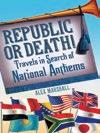
Republic or Death! Travels in Search of National Anthems by Alex Marshall is published by Random House at £14.99

endlessly engrossing Republic or Death!—a book that makes you realise how wrong most of us have been to take national anthems for granted, as if they somehow just appeared, rather than being the products of often fascinating history.
And some of it is surprisingly recent. Only in the 1920s, for example, did the Olympic committee decide to play the winning athletes’ national anthems—which, for many
| 09•2015 126 BOOKS
REcoMMENDED READ
© Sp ORT I N pICT u RES /A LAM y
countries was the cue to make sure they had one. And even then, America didn’t adopt “The StarSpangled Banner” until 1931.
Marshall mixes the history and plenty of memorable incidental facts with some equally good travelogue, as he journeys from Japan to Kazakhstan, Bosnia to Nepal, to investigate the origins and significance of anthems all over the world.
Just read some of their lyrics. They are like epics, setting down for posterity the entire history of their country and its people, the woes they suffered, the pain they bore, and which then swear that they will never go through such ills again. It’s not hard to work out who the villains are in these songs: the Spanish and Portuguese who once tried to control the continent. ‘Don’t you see them over sad Caracas/ Spreading mourning, weeping and death?’ goes Argentina’s. ‘Don’t you see them, like wild animals/ Devouring all people who surrender?’ Fortunately, heroes are at hand: ‘ “Down with the chains!” / the gentleman yelled,/ And the poor man in his hovel/ For freedom implored,’ goes Venezuela’s, sounding more like a Dickensian novel than an anthem. ‘For a long time the oppressed Peruvian,/ Dragged an ominous chain/…he quietly moaned,’ adds Peru’s in a similarly dramatic vein.
Rd eXCLUsiVe: aLeX MaRsHaLL’s CHOiCe OF stRaNgest NatiONaL aNtHeMs
The Netherlands’ Het Wilhelmus (1570s) If you were to guess which country’s anthem climaxes with the words, “The King of Spain, I’ve always honoured,” chances are you’d go for, well, Spain’s. It’s actually the Netherlands.
Burundi’s Our Burundi (1962)
Burundi sits in the middle of Africa, but from its anthem you’d guess it was actually in the American West and filled with cowboys. The perfect sound-track for horses lolloping through the countryside.
Mauritania’s National Anthem (1960) It’s rhythm is so complex that every person sings it very differently. If you know how it’s actually meant to go, please tell me.
Nepal’s Made of Hundreds of Flowers (2007) Nepal’s is the bizarre—joyful—exception to most British-sounding anthems. Written on Casio keyboard, it’s Asian pop music that couldn’t be further from England.
09•2015 | | 127 Reade R ’s d igest
‘‘
‘But as soon as the sacred cry,/ “Freedom!” was heard,/ The slave’s indolence shook / [And] his humiliated, humiliated,/ humiliated neck rose up’…
The anthems then tell of the battles that were fought for independence, the blood that was spilled and the
to ash so there will be nothing for the Spanish to enslave, an approach I doubt many Ecuadorians would be happy with.)
It is easy to get lost in the sheer eccentricity of these songs—every time I read Colombia’s I end up gawping at a verse that starts, ‘In
They encapsulate the desire to fight and die for your land; that need to keep what’s yours forever
revenge that was had. You would think that all that would be left to do after that would be to celebrate victory, but practically all South American anthems then make sure to warn people that the Europeans could one day be back; that ‘the barbaric injustice of fate’ might force new chains around people’s wrists. If that happens, everyone must be prepared to fight again. (Ecuador’s anthem is one of the few that doesn’t call for more fighting, instead asking for a volcano to erupt and turn everything

AND THE NAME oF
THE AUTHoR is… Lewis Carroll, author of the Alice books, whose day job was as a maths don. (The believer in impossible things is The white Queen in Alice Through the Looking Glass.)
agony, the Virgin/ Tears her hair out’—but there is a serious point to them that you shouldn’t miss: South America’s anthems get to the point of what nationalism is meant to be about better than any others. They all say, in no uncertain terms, ‘This is my land and I’m prepared to die for it.’
The anthem that does it best of all is Paraguay’s. ‘Republic or Death’, it says in its very title, a message that could not be clearer if the anthem were called, ‘Step on My Land and I’ll Slit Your Throat’. ‘¡República o Muerte!’, to use the Spanish, are three words that say more about what is meant to be at the heart of nationalism than entire books on the subject do. They encapsulate that desire to fight and die for your land; that need to keep what’s yours for ever, no matter how arbitrary or recent a creation your country actually is.”
| 09•2015 128 BOOKS
’’
© “L E w IS C ARROLL 1863” B y O SCAR Gu STA v E R E j LANDER
Books
that changed my li F e

John Banville is the irish author of 16 novels, including The Sea, which won the 2005 man Booker Prize. he’s also the recipient of the Franz Kafka Prize. his latest book The Blue Guitar is published by viking this month.
The Catholic Church Catechism
I won’t claim to be glad of the change the Catechism wrought in me—from heedless little savage to cowed Christian—but it was certainly momentous. The Catechism has the lowdown on everything. Some confusion was inevitable, for a child first introduced to these mysteries at the age of seven—for instance, I thought for a long time that adultery was so-called because only adults do it—but the priests were always on hand to explain all. If only it could all have been true...

poetry is and, more significantly, what poetry can do, were transformed. The first line of the First Elegy— “Who, if I cried, would hear me among the angelic orders?” —was a clarion for me as an artist and, at a deeper level, as a human being.
The Portrait of a Lady
By HenRy JaMes
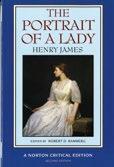
Duino Elegies
By RaineR
MaRia Rilke
I read the Elegies first in the early 1970s, in the old LeishmanSpender translations, and at once my notions of what
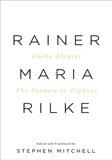
If Rilke altered my view of poetry, this marvellous novel transformed entirely my conception of the novelist’s calling. I read The Portrait in 1973, when I was staying near the church of Santa Maria Novella in Florence, close by where James himself had lodged when he was writing the book, and at once I understood that the novel was a form in which one could make works of art. James took the Victorian novel, loose and baggy monster that it was, and made of it something new and transcendent. As told to Caroline Hutton
09•2015 | 129
B y a
© “John Banville 2090”
madalvarez
FOR MORE, GO TO ReaDeRsDiGesT.CO.Uk/BOOks
You Couldn’t Make It Up
Win £50 for your true, funny stories! Go to readersdigest. co.uk/contact-us or facebook.com/readersdigestuk
I Was DRIVInG aLOnG with my three-year-old son in the back of grandad’s car. My son was sitting behind his grandad and staring intently at the back of his head. Suddenly, he burst out, “Grandad! Is your hair growing or going?”
HeIDI CLaRK, York
aFTeR senDInG seVeRaL emaILs to the wrong people, plus making silly spelling mistakes, I knew I needed to go and get my eyes checked.
This fact became all the more obvious when one day I screamed at my friend to stop the car, leaping out to help the little old man bent over at the side of the road. “He” turned out to be nothing more than a large, free-standing rubbish bin.
But the icing on the cake— or the final straw—was when I followed the wrong person around the supermarket, putting things in his trolley.
I’m pleased to say I’m now sporting an appropriate pair of spectacles!
KaTH sHaRman, Yorkshire

“Look! That cloud up there looks just like a cloud
I Was aT mY sIsTeR’s HOUse when my nephew came in from the garden in a very dirty and dishevelled state. He asked my sister, “Who am I?”
Thinking he was playing a game, she replied, “I really don’t know— who ARE you?”
My nephew looked shocked. “Our neighbour was right,” he said. “She told me I was so dirty that my own mum wouldn’t recognise me.”
Lena HeXman, Clwyd
| 09•2015 130 FUn & Games
Cartoon By Steve Jone S
I Was TeaCHInG an adult class on coping with stress, and decided to light a scented candle to help create a soothing atmosphere.
Just as I was explaining how to respond calmly to a stressful situation, the fire alarm went off. As the building was evacuated and the fire brigade arrived, I was hyperventilating in the car park, assuming it was my scented candle that had set off the alarm. It was only after the fire brigade informed us that it was the toaster in the kitchen that had triggered the alarm that I began to calm down.
“Not exactly practicing what you preach!” said one student.
JOanne CamPBeLL, Northern Ireland
I Was WORRIeD because my daughter was walking home from school in a thunderstorm. She was with friends, but I thought she would be scared.
As she came through the door, however, she was excited. “God has been taking my picture all the way home!” she said enthusiastically.
Jeena sUmneR, London
mY HUsBanD went to our local supermarket to buy a four-pack of beer. He reached up to a high shelf and as he was lifting it down, a can fell out.
It hit the floor and exploded with a very loud bang, and a lady shopper nearby was hit on her backside. My
husband told her that it must have been the widget from the can.
Three security men arrived on the scene and questioned the lady, who replied, “This man [my husband] said a midget has hit me, but I didn’t see one.” My husband—still covered in beer—endeavoured to explain what had happened, only to be asked if he’d been drinking!
KaRen HOLYOaKe, Hertfordshire
I Was FLICKInG THROUGH the family Bible with my nephew. As we turned the page, something fell out.
He picked it up and saw it was a leaf that’d been pressed between the pages. “Look what I’ve found,” he said. “I think it must be Adam’s underwear.”
mICHa BRYn, Merseyside
COLIn Was One OF 39 four-yearolds in a class I taught some years ago. He was feisty and forthright, with big brown eyes. I couldn’t help liking him. He had a problem, though. His classmates called him “Stinker”, and it was difficult to breathe naturally when you came anywhere near him.
The headteacher, always supportive, wrote a gentle letter home, encouraging Colin’s mother to give him more frequent baths.
Feistiness was a quality that seemed to run in the family, however, because when the reply came, written on a scrap of paper, it was this: “Don’t smell him. Learn him.” To the point!
VeROnICa BRIGHT, Cornwall
Reade R ’s d igest 09•2015 | 131
Buy One Frying Pan & Get One FREE Only £14.99*
Oil FREE Cooking with 100% Nonstick Ceramic Frying Pans. Start healthy cooking now with less fat, less energy and more taste. Cook with NO oil, NO fat and NO butter

■ Environmentally friendly
■ Scratch resistant and super non-stick ceramic coating
■ Suitable for gas, electric and ceramic hobs
■ Heat resistant soft touch silicon coated ‘easy grip’ handles
■ Easy to clean & dishwasher safe
All pans available in four colours Red, Green, Black or Cream. Visit our website to see our full range of cookware and bakeware sets.
Product Code: P10419 Set of 2 Frying Pans £14.99 (*plus £4.95 p&p). Size: 24cm and a 20cm pan
To Order: shop.readersdigest.co.uk
• CALL 0844 332 8080
• Quote RDP031 when ordering

Super tough nonstick ceramic coating


Cook with no oil, no fat & no butter
it pays to increase your
Word Power
“Come autumn’s scathe—come winter’s cold— Come change—and human fate!” Elizabeth Barrett Browning writes in “Autumn”, a reminder to embrace the changes that the seasons bring. In accord, a collection of words about change. Answers on next page.
By Emily Cox & H E nry r at H von
1. tack (‘tak) v—A: switch horses. B: follow a zigzag course. C: tailor a suit.
2. ferment (fur-‘mehnt) n—A: state of unrest or disorderly development. B: improvement. C: evaporation.
3. synchronise (‘sin-kreh-niyz) v—A: cause to coincide. B: increase speed. C: move one’s lips.
4. static (‘sta-tik) adj—A: in a frenzy. B: unchanging. C: moving through space.
5. flux (‘fluhks) n—A: series of failures. B: continued flow. C: rapid rise.
6. vicissitudes (vuh-‘si-suh-toods) n—A: exact opposites. B: minor adjustments. C: ups and downs.
7. fickle (‘fih-kuhl) adj—A: beginning to decay. B: marked by a lack of constancy. C: stuck in a rut.
8. ameliorate (uh-‘meel-yuhrayt) v—A: make better or more
tolerable. B: make worse. C: turn upside down.
9. immutable (ih-‘myu-tuh-buhl) adj—A: in motion. B: not susceptible to change. C: becoming a monster.
10. adapt (uh-‘dapt) v—A: spread gradually. B: become airborne. C: make fit, usually by alteration.
11. crescendo (kreh-‘shen-doh) n—A: sudden narrowing. B: gradual increase. C: change in color.
12. hiatus (hiy-‘ay-tuhs) n
A: growth spurt. B: interruption in time or continuity. C: change of season.
13. agitate (‘a-juh-tayt) v
A: replace. B: break into bits. C: disturb emotionally.
14. senescent (sih-‘neh-snt) adj
A: getting old. B: catching fire. C: developing a fragrance.
15. incorrigible (in-‘kor-uhjuh-buhl) adj—A: rustproof. B: spontaneous. C: not reformable.
09•2015 | 133
answers
1. tack—[B] follow a zigzag course. “Deftly, the captain tacked through the rocky shoals of the bay.”
2. ferment—[A] state of unrest or disorderly development. “Henry’s writer’s block was followed by a creative ferment in his poetry.”
3. synchronise—[A] cause to coincide. “Before we begin the race, let’s synchronise our watches.”
4. static—[B] unchanging. “Alison found the novel’s characters to be a bit static and one-dimensional.”
5. flux—[B] continued flow. “It’s too soon to predict the election— everything’s in flux.”
6. vicissitudes—[C] ups and downs. “One thing I’ve learned: life is anything but constant, so enjoy its vicissitudes.”
7. fickle—[B] marked by a lack of constancy. “Tara described her niece as ‘fickle at best’ after their visit to the toy store.”
8. ameliorate [A] make better or more tolerable. “I find that just 15 minutes of yoga daily ameliorates my worries.”
9. immutable—[B] not susceptible to change. “Apparently, my upstairs tenant thinks loud, thumping music is his immutable right.”
10. adapt—[C] make fit, usually by alteration. “If you want to eat vegan, I can adapt the recipe.”
11. crescendo—[B] gradual increase. “The concerto ended with a huge and effective crescendo.”
12. hiatus—[B] interruption in time or continuity. “The debate was marked by an uncomfortable hiatus before the incumbent responded.”
13. agitate—[C] disturb emotionally.
“If you ask me, those therapy sessions just agitate Karyn even more.”
14. senescent—[A] getting old. “The rocking chair is gorgeous, but do you really see me as senescent?”
worD oF tHE Day*
FriaBlE: crumbly; as friable top soil.
alternative suggestions:
“a competent monk.”
“used by employers to describe those who always call in sick during the week, but are miraculously cured by Friday night.”
“stephen Fry’s special abilities.”
15. incorrigible [C] not reformable. “I’m afraid our new puppy is simply incorrigible when it comes to sleeping on the couch.”
voCaBUlary ratinGS
9 & below: ready for an upgrade
10–12: Getting ahead
13–15: emerging anew
Word Po W er | 09•2015 134 p o
*POST YOUR DEFINITIONS EVERY DAY AT FaCEBooK.Com/rEaDErSDiGEStUK


Saving you time and mess with this Cordless Window Vac

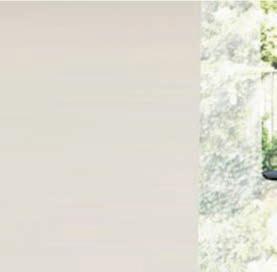



Tired of annoying streaky windows? This is the new, timesaving, fun way to get windows clean, and sucks away dirty water leaving no messy drips.


■ A fast and effective way to clean and dry all your windows
■ Suitable for both indoor and outdoor use
■ Leaves no water marks, smears or drips
■ Perfect for all types of glass – windows, cars, mirrors, shower screens, conservatories and much more!
And it’s so easy and simply to use... Simply spray the surface with detergent, clean the surface with a cloth, and vacuum the water away, leaving the surface gleaming and streak-free!
Product code: P10716 RRP £59.99 - You Save £35!
*plus £4.95 p&p
To Order: shop.readersdigest.co.uk
• CALL 0844 332 8080
• Quote RDP031 when ordering



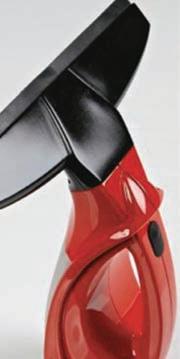



Subscriber Offer
ONLY £24.99*
BrainTeasers
Challenge yourself by solving these puzzles and mind stretchers, then check your answers on page 139.
THE COMPLETE SET
In each column there are two dominoes. Each of these pairs obeys a certain rule, so that together they make a set. Among the options below, which other pair of dominoes belongs to this set?
CRYPTIC EQUaTIONS
Each letter in these equations stands for one of the seven numbers listed below. No two letters have the same numeric value.
Match each letter to a number to make the equations work.
| 09•2015 136
a b C
2 4 5 6 7 8 11 C + L = z z – H = E a x H = Q Q — : a = H
FU N & Ga MES
WHaT’S NEXT?
Which object comes next, logically, in the sequence?
TRIaNGLE HUNT
How many triangles can you find? Note that a triangle can be made up of smaller segments, including other triangles.
THE MISSING LINK
What number is missing from the square?
09•2015 | | 137 2 3 5 2 1 0 2 9 6 3 ? 0 3 6 2 1
a b C
FLYING COLOURS
The clues are standard, but the letters in the coloured squares are an anagram of a creature that might be attracted to a 24 across
| 09•2015 138 brain teasers
aCROSS 01 Stood up to (5) 04 Book room (7) 08 Coming up (7) 09 Examination (5) 10 Advantage (4) 11 Famous Apache (8) 13 Peculiarly (5) 14 Hold up (5) 19 Retaliatory action (8) 21 Mix with spoon (4) 23 Last letter of Greek alphabet (5) 24 Flourish (7) 25 Over the top (7) 26 Foundation (5) aNSWERS :aCROSS 1 Faced 4 Library 8 Looming 9 rialt 10 dgee 11 Geronimo 13 Oddly 14 Delay 19 eprisalr 21 tirs 23 Omega 24 lossomb 25 xtremee 26 asisb :OWND 1 Falter 2 Clogged 3 Dais 4 Logged 5 uttonedb 6 libia 7 Yellow 12 Ultimate 15 ttestsa 16 Groove 17 abbler 18 romasa 20 Pleat 22 ombt :MaGRaNa utterflyb DOWN 01 Hesitate (6) 02 Blocked (7) 03 Platform (4) 04 Recorded (6) 05 Fastened (8) 06 Excuse (5) 17 Cowardly (6) 12 Final (8) 15 Witnesses (7) 16 Furrow (6) 17 Mob (6) 18 Perfumes (6) 20 Fold (5) 22 Sarcophagus (4) 1 2 3 4 5 6 8 9 10 11 12 7 13 14 15 16 17 18 19 20 21 22 23 24 25 26
* Entry is open only to residents of the UK, Channel Islands, Isle of Man and Republic of Ireland aged 18 or over. It is not open to employees of Vivat Direct Limited (t/a Reader’s Digest), its subsidiary companies and all other persons associated with the competition.
Brainteasers: Answers
THE COMPLETE SET
C. In each pair, if you add the dots in the bottom domino and then multiply this sum by two, you’ll produce the total number of the dots in the top domino. For example, in the first pair, the bottom domino has five dots in total, and the top one has twice as many—that is, 10 dots.
CRYPTIC EQUaTIONS
A = 2 H = 4 C = 5 L = 6
E = 7 Q = 8 Z = 11
WHaT’S NEXT?
A. The number of sides on the outer figure decreases by two with each step in the sequence: dodecagon, decagon, octagon, hexagon. The middle figure increases by one side each time: triangle, square, pentagon and so on. The innermost figure alternates between octagon and pentagon—or, if you prefer, it’s an octagon when the middle figure has an odd number of sides and a pentagon when the middle figure has an even number of sides.
TRIaNGLE HUNT 66
THE MISSING LINK
3. The numbers in each row and column add up to 12.
£50 PRIzE QUESTION
answer published in the October issue
Which is the odd word out?
the first correct answer we pick on september 3 wins £50!* email excerpts@readers digest.co.uk 9
aNSWER TO aUGUST’S PRIzE QUESTION
VISIbILITY
it contains the name of a bird (ibis), in reverse. all the others contain names of water creatures in reverse: paddock— cod; asleep—eel; impractical— carp; embarcation—crab.
aND THE £50 GOES TO… John royal, Durham
09•2015 | | 139
R E a DER ’ S D IGEST
6 5 7 4
8 11 9 10 13 15 12 11 13 14 17 15 16 19
19 21 18 17
7
X
Laugh!
Win £50 for every reader’s joke we publish! Go to readersdigest. co.uk/contact-us or facebook.com/readersdigestuk
A YOUNG WOMAN on a flight from Ireland asked the priest beside her, “Father, may I ask a favour?”
“Of course, child. What may I do for you?”
“Well, I bought my mother an expensive hair dryer for her birthday. It’s unopened but well over the customs limits, and I’m afraid they’ll confiscate it. Could you carry it through customs for me? Hide it under your robes perhaps?”
“I would love to help you, dear, but I must warn you, I will not lie.”
“With your honest face, Father, no one will question you.”
When they got to customs, she let the priest go first. The official asked, “Father, anything to declare?”
“From the top of my head down to my waist, I have nothing to declare.”
The official thought this answer strange, so asked, “And what do you have to declare from your waist to the floor?”
“I have a marvellous instrument designed to be used on a woman, but which is, to date, unused.”
Roaring with laughter, the official said, “Go ahead, Father. Next please!”
BILL BOYLE, Stirlingshire
EVERYBODY IS CORRUPTED by hotel rooms. You can’t help it. It’s the only place in the world where you walk in and the first thing you do is steal everything before you take your coat off.
COMEDIAN DYLAN MORAN
AN EMPLOYEE at an orange-juice factory was asked how he’d won the employee of the month award.
“Well,” he said, “I just concentrate more on my job than my colleagues.”
BRENDAN PHILLIPS, Dublin
I NEVER WANTED TO BELIEVE that my dad was stealing from his job as a road-worker. But when I got home, all the signs were there. SEEN ONLINE
MY GRANDMOTHER started walking five miles a day when she was 60. She’s 97 now and we don’t know where on earth she is.
COMEDIAN ELLEN DEGENERES
| 09•2015 140 FUn & Games
A CHILD ASkED HIS MOTHER, “How were people born?” So his mother said, “Adam and Eve made babies, then their babies became adults and made babies, and so on.”
The child then went to his father and asked him the same question. His father explained, “We were monkeys, then we evolved to become like we are now.”
The child ran back to his mother and said, “You lied to me!”
His mother replied, “No, your dad was talking about his side of the family.”
LAUGHFACTORY.COM
I’M NOT BEING CONDESCENDING, I’m too busy thinking about far more important things you wouldn’t understand.
COMEDIAN JIMMY CARR
A MARRIED COUPLE, Harry and Esther, were out shopping one morning when Esther said, “Darling, it’s my mother’s birthday tomorrow. What shall we buy for her? She said she would like something electric.”
Harry replied, “How about a chair?”
SEEN ONLINE
WHAT’S THE OPPOSITE of opposite?
Consider yourself bamboozled!
COMEDIAN RUSSELL HOWARD
POLICE ARRESTED TWO kIDS
YESTERDAY. One was drinking battery acid, the other was eating fireworks. They charged one—and let the other off.
MIRROR.CO.Uk
CURIOUS CROCkERY
A Twitter campaign is mocking the trend for serving meals on bizarre objects (as seen @WeWantPlates)
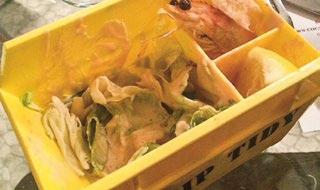



Reade R ’s d igest 09•2015 | 141
A DUCk WALkS INTO A SHOP and asks the manager if he sells oranges. The manager says, “No, we don’t,” so the duck leaves.
The next day the duck goes back to the same shop and asks the manager if he sells oranges. The manager says, “NO, we don’t sell oranges,” so the duck leaves the shop.
The next day the duck goes back to the same shop and asks the manager if he sells oranges. The manager is furious now and says, “ NO, WE DO NOT SELL ORANGES! IF YOU COME BACK AND ASK IF WE SELL ORANGES AGAIN, I WILL NAIL YOUR BEAK TO THE FLOOR!”
The next day the duck goes back to the same shop and says to the manager, “Excuse me, do you sell nails in this shop?”
The manager says, “No, we don’t sell nails.”
The duck replies, “That’s good. Do you sell oranges?” SEEN ONLINE
POSH HOTELS have a turn-down service. I had never heard of this. There was a knock at the door and a woman said, “I’ve come to turn down your bed.”
To which I said, “Well, many women have in the past. Why should you be any different?”
COMEDIAN MICHAEL MCYINTYRE
A CENTURION WALkS INTO A PUB and asks for a Martinus. “Don’t you mean a Martini?” says the barman.
“No,” says the Centurion. He sits before adding, “If I want a double I’ll ask for one.” SEEN ONLINE

YOU CAN’T TEACH THIS
The Sixth Form Poet is supposedly young in years—but wise in words. He or she regularly philosophises in 140 characters or less. As seen on Twitter.
The real tragedy of Goldilocks And The Three Bears is that Mr and Mrs Bear, a young married couple, already sleep in separate beds.
Zombies are a fun reminder that the first thing people want to do when they’re dead and beyond the law is murder everyone in sight.
I have an inferiority complex AND a superiority complex. You probably hate me and one day I’ll explain to you why.
I wasn’t yawning, I was doing an impression of a lion roaring his delight at your fascinating story.
Laugh | 09•2015 142
Beat the Cartoonist!

Think of a witty caption for this cartoon—the three best suggestions, along with the cartoonist’s original, will be posted on our website in midSeptember. If your entry gets the most votes, you’ll win £100 and a framed copy of the cartoon with your caption.
Submit to captions@readersdigest.co.uk or online at readersdigest.co.uk/caption by September 11. We’ll announce the winner in our November issue.
July’s Winner

This was the first outing for cartoonist Graeme Youngson, and he’s won over the public already! His caption, “After finally completing the tapestry, Bertrand began his long, weary walk home,” secured victory by a wide margin, attracting nearly double the votes of its nearest rival. You can’t keep the professionals down for long.
SCOREBOARD: reaDers 32 cartoonists 12
in the october issue

Votes for Women!
Carey Mulligan talks about the new British film Suffragette and bringing history to the screen
Plus
• Guide Dogs for the brain
• the Latest on cholesterol
• Family Photo competition Winners
• i remember: ben Fogle
• british nGos in Gaza
Reade R ’s d igest 09•2015 | 143
Bo TT o M : © GRAEME You NG S o N / Top: © pETER K ING / © p ATH é p R odu CTI o NS
60-Second Stand-Up
We caught up with comedian
WHAT’S YOUR FAVOURITE YOUR OWN JOkES?
I used to open a show by looking at the audience and saying, “What are they singing about in opera?” I’d then pretend to be a tenor and start singing utter filth.

WHAT’S THE BEST PART OF YOUR CURRENT TOUR?
I tell the true story of how I was once writing in chalk on the pavement, when a pensioner came up to me and said, “Putin is trying to stop this. I will join you.”

YOUR MOST MEMORABLE HECkLE?
One lady heckled me and apologised for it when we met 25 years later.
FUNNY TALES ABOUT A TIME YOU BOMBED ON STAGE?
One time I was performing at a student union in Scotland. It wasn’t the best gig in the world, and I got escorted out by security. They’d quite literally got me a taxi.
WHAT’S YOUR FAVOURITE ONELINER?
I don’t want to achieve immortality through my work; I want to achieve immortality through not dying.
WHO’S YOUR COMEDY INSPIRATION?
Dave Allen, Alexei Sayle, Woody Allen...generally people who do things their own way.
IF YOU COULD HAVE A SUPER POWER, WHAT WOULD IT BE?
I’d have the Midas Touch in reverse: the Pauper’s Touch. Anywhere the rich were getting too uppity, I’d go round with my power of penury and make them poor.
Mark’s show Trespass is currently touring. For more details and to book tickets, visit markthomasinfo.co.uk
Laugh | 09•2015 144
FOR MORE, GO TO READERSDIGEST.CO.Uk/FUN-GAMES © S TE v E u ll ATH o RNE
BOOKSHOP


WE HAVEN’T READ EVERY BOOK IN OUR BOOKSHOP...


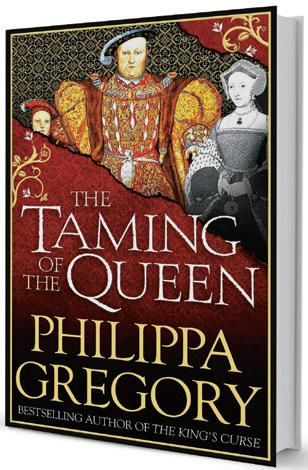


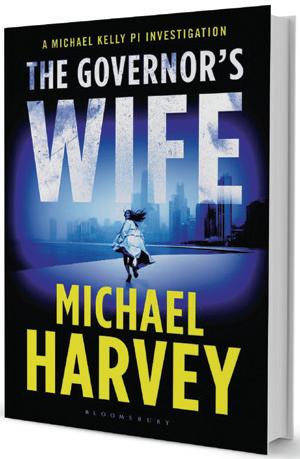
…but we work closely with a select group of publishers to hand-pick books we know you will enjoy. Of course we also bring you the books we choose to read ourselves. From literary fiction to popular non-fiction, creative cookery books to gardening for pleasure – and the newest releases alongside timehonoured favourites – we present a distinct range customised for our discerning readers.
When Reader’s Digest was first published over 90 years ago it quickly became one of





the most popular magazines in the world, celebrated for stories and articles, both real-life and fictional, that everyone loved to read and share. At home, on the train – and of course, at the doctor’s.
One of our strengths has always been our nose for a good story, and we’re extending that fine tradition into our online bookshop.
Why wait any longer? Visit shop.readersdigest.co.uk/books and browse through our shelves.
READING MATTERS AT READER’S DIGEST
When you log on, sign up to our weekly newsletter. We’ll keep you informed of new books in the shop and you’ll be the first to hear about exclusive competitions and special offers. PLUS – every time you open a fresh newsletter you’ll be entered in our monthly prize draw to win £200 to spend in the shop!
Win £200































 tom Browne
tom Browne

































































 By tom B rowne
By tom B rowne












 Midge with his older brother and uncle George. “We didn’t have a lot, but what we had was each other”
Midge with his older brother and uncle George. “We didn’t have a lot, but what we had was each other”










































































































































































































































































